Australian Terrier International
Meeting The Needs Of Aussie Owners Globally
© 2010 Australian Terrier International
March 2011-Vol 2, Issue 3
|
|
|
|
|
|
| Dear Friends, |
| This month we are excited to bring you the beautiful Aussies of Denmark. Denmark was home to the World Show in 2010 and I had the great pleasure of being there and meeting the many wonderful European Aussie breeders, dogs and friends of Denmark.
The Danish people are delightful, generous and very cordial hosts. If you get the chance to go to Denmark to meet them, I urge you to go! We hope you enjoy the photos, the stories, the people and the dogs of Denmark.
Business
We want to remind you that we have a new ATI site and if you are a paid member you will need to log in again to request a new user name and password. If your membership has expired it will let you know when you log in that your annual payment is due. Thank you for your support and positive feed-back and making the site so popular.
iPad Users
Please make sure you do the most recent iPad update and download to enjoy your ATI newsletter to it’s fullest. Remember to give the newsletter time to load all the photos.
Beliefs
We are proud to represent you and be out in front as the Innovators. If you like our ideas ATI is pleased to share them with everyone and every club, in every country. ATI is happy and proud that so many of you embrace our thoughts, concepts and ideas. Please write us for permission to reprint articles.
Respectfully,
Pamela Levy
Editor
|
| ATI Website |
|
Our newest addition to the website is our monthly
Featured Family.
Our first Featured Family is:
Jorgen Gronlund and his wife Deborah Sommer
from Denmark.
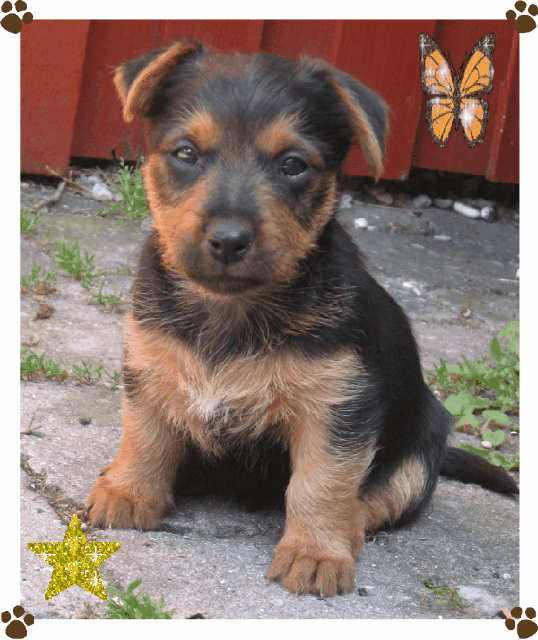
To read more about them and enjoy their dogs please click here. Guaranteed to bring a smile to your face.
|
|
|
|
| Congratulations Lifetime Member Jill Grenaae of Kennel Tatong |
| ATI congratulates Jill Grenaae for her contributions internationally to the Australian Terrier Breed. We are proud to make her our First Danish Lifetime Member.
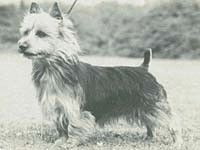
“Moondancer” IntCh Tatong’s Silver Moondancer (Owner Jill Grenaae)
By Angie Cross Bly
When Pamela asked me to contribute “a little something” about Jill Grenaae, I was a little stymied.
How can I write “a little something” about a mentor, a role model, a shoulder to cry on, a booster when things go well, and above all a friend.
Just about every breeder in Scandinavia has Tatong dogs in their pedigrees; this fact is well known. Her dogs are known for beauty and soundness and it is a great loss to Australian Terriers that she left the breed. In spite of her no longer breeding Aussies, I feel I can turn to her for advice, consolation, needed scoldings and praise.
When she and Tina Nordgren came to visit me in Colorado, we took a drive through the Rocky Mountain National Park. It was before GPS was widely available and I had to plot my course on my desktop. Little did I know that I had to place the dots directly on the road; consequently, when often there was a drop of hundreds of feet off the right side, the “voice” would tell us “in 100 feet, turn right.” By the time we finished the drive we were hysterical with laughter and the “voice” was named “the Bitch in the Box.” I count Jill as one of my most treasured friends and I hope to see her again soon.
By Sheila Dunn
What can I say about Jill?
I can say that the world of Australian Terriers lost a great friend and guardian
when Jill switched her breeding program to Labs.
I can say that the world of Labs has gained a great intellect,
and a breeder of great ethics.
I can also say Jill is the first one I contact when I have an issue that
needs reason and knowledge beyond my own.
What else can I say about Jill?
She is one of the funniest Ladies I know!
And I thank her every day for Bessie’s wagging tail.
______________________________________________________________________________
An Interview With Jill Grenaae by Pamela Levy
__________________________________________________________________
To print this article without background color click here.
We want to thank you, Jill, for your years of dedication to the breed. The kennel name Tatong is behind many top winning Danish, American and international dogs. We would love to know how you became involved or started with Australian Terriers?
First of all I want to thank the ATI and the Aussie people of Denmark for the honor of being awarded an ATI Lifetime member – Thank you!
A friend of mine bought an Aussie puppy back in 1979. At that time we were studying and living in Copenhagen and wanted a small dog that could go everywhere with us, one we could take with us on the bus or train or could be transported in the basket of my bicycle. Having met my friend’s Aussie puppy the choice was not hard and in July 1981 our first Aussie, Emma, entered into our lives. Unfortunately Emma was quite a nervous dog; she loved other dogs, but was not comfortable around people she did not know, so when she was a year old we decided that she might benefit from the company of an older dog with a more even disposition. Emma’s breeder knew of another Aussie breeder who had an adult female, Sam-Zu Ngulati, for sale on breeding terms and the rest is, as they say, history. Ngulati was a lovely bitch with an outstanding temperament and as she turned out to produce equally lovely offspring, she became the foundation of the Tatong Aussies, primarily through her son MultiCh Tatong’s Silver Moondancer.
Looking back, I did not choose the breed as much as it chose me. Firstly I stumbled over the breed by chance and secondly I had no option but to breed two litters from Ngulati if I wanted to have her. Also the first puppy I kept from her was one that the family that was supposed to have her “forgot” to pick up when the time came for the puppies to leave home so somewhere something had really decided that this was to be my breed. This “forgotten” puppy ended up staying with us and, by the way, became my first champion.
How many years did you show Aussies?
I began showing Aussies in 1980. The first dog I showed was Emma, our first Aussie, and when she won the bitch ticket and BOS at her first show, I was hooked.
How many years were you involved with breeding Aussies?
Our first litter was born on June 29th, 1985.
How many litters did you breed?
I don’t know; I never counted litters, but according to the DKC database, I have bred a little less than 400 Aussie puppies in about 25 years.
Do you know how many champions you have produced?
That I DO know – 78, several of them with multiple champion titles.
Do you enjoy mentoring other people in the breed?
I do and mostly when the “student-mentor” relationship turns into a friendship and the student into an accomplished breeder.
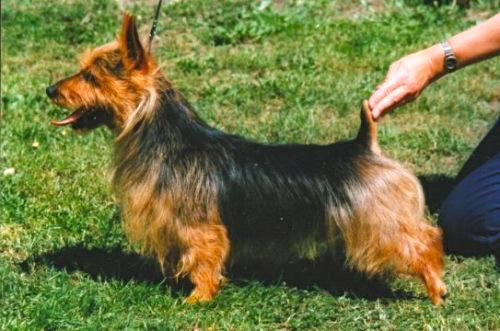
IntCh Golden Moonraker du Clos de Windorah
(Breeder Muriel Froelich, Owners Jill Grenaae, Pia Lindqvist)
Have you mentored anyone from another country?
Yes, several and it has been a pleasure.
Who were the people who mentored you in the breed?
Betty Bryde of Mariendal Australian Terriers and Ibeth Carlsen of Ibeth Aussies were my mentors. They were both dedicated to the breed and I know that, even if she can no longer keep dogs, Betty still is. I had two lovely dogs from Ibeth, IntCh Ibeth Orange Blossom and IntCh Ibeth Mister President that are both behind many successful Tatong Aussies. From Betty I got a wealth of knowledge about the breed. Betty is a dear, much loved friend and a breeder whose opinion one would be a fool not to value.
What do you look for in the bitch to make her worthy of your breeding program?
A happy, outgoing, even temperament, good health and correct breed type and anatomy – in that order. It has been my goal to get all in one package so to speak, but it is my firm belief that, first and foremost, no dog with a faulty temperament should reproduce.
A very good friend of mine says that an Aussie should be a terrier first and then an Aussie. I completely disagree and I do so because of the unique disposition of the Aussie. I love that this breed is bold and forward, but it should never be so to the point of stupidity. This is why, unlike many other of the terrier breeds, Aussies thrive in packs and are so easy to keep.
What do you look for in the stud dog to make him worthy of your breeding program?
I look for the exact same things as in a bitch. An additional thing that really comes under health is that both should be able to reproduce naturally. Now that I am involved with another breed that has marathon whelpings, I can see how privileged I was with the Aussies. Aussie bitches are great whelpers and the dogs are good studs that usually have their timing exactly right.
How did you learn to groom?
I learned grooming from Ibeth Carlsen.
Have you exported Aussies and to what countries if yes?
Yes, I have exported several dogs – just off the top of my head to: Finland, Sweden, Norway, Germany, France, The Netherlands, Italy, Croatia and The US.
Have you sold Tatong dogs to many people in the US?
I have had the pleasure of selling dogs to several breeders/good friends in the US: Sheila Dunn of The Farm’s Aussies, Angie Cross-Bly of Sundog, Jerry Walsh of Pineterri, Cheryl Mechalke of Araluen, Mrs. Edla Cummings of Edwyre.
Are there others elsewhere in the world that you helped start with showing and breeding?
Yes, I have helped breeders in France, Germany, Sweden, Finland, The Netherlands, Italy and of course Denmark. All have started breeding with dogs from us.
Have you imported Aussies?
Yes, also several. From The UK, The US, Sweden, Finland, Norway and The Netherlands. A few stand out in particular, among these, two bitches from Finland, IntCh Selendia Blue Moonshine, a daughter of our own Silver Moondancer and bred by our good friend Pia Lindqvist. The other Ch Avocation Double Action, a beautiful red, bred by another wonderful friend Orvokki Lämsä. Double Action proved to be a wonderful producer that gave us several lovely champions. From England I had Ch Elve The Flirt. I got her when she was three years old. She had only a few puppies and sadly got diabetes at the age of 7, which is why the few puppies she had were never bred but she was a lovely dog that, with the proper treatment, lived to a very old age despite her diabetes. Writing this I still miss her even though she has been gone for several years now; she was a real character. The two daughters The Flirt produced here have, luckily, both been healthy. One
is still active as an agility dog at the age of 13 and the other is the head of her
pack at 14.
Do you see a difference in personalities between dogs from other countries and Danish dogs?
No, but I see differences in personalities between dogs from different breeders of course reflecting what the breeder values.
Did you find it difficult to produce a nice natural tail?
Docking was banned in Denmark in 1992, which was well before I stopped breeding. I absolutely hate the curled up tails, so I selected for tails that were as straight and short as possible and I don’t think it was a problem at all.
Can you describe what a good natural tail should look like?
A good natural tail should be quite similar to a Cairn Terrier tail, carried at approximately 90-80 degrees with the back. I will accept a tail that is carried a little gaily, but never curled.
Did you have a few favorite Aussies that you owned or bred?
MultiCh Tatong’s Silver Moondancer (Intch Ibeth Mister President x Sam-zu Ngulati) and MultiCh Tatong’s Crocodile Dundee (Ch Asterix x Ch Tatong’s Obiana) are my absolute favourites among the dogs that I have owned and bred, but also dogs owned by others such as MultiCh Tatong’s Red Oak (Ch Sassatown Gianni Schicchi x Ch Avocation Double Action), IntCh Tatong’s Dr. Jekyll (Ch Selendia Galaxy Kid x Ch Avocation Double Action),
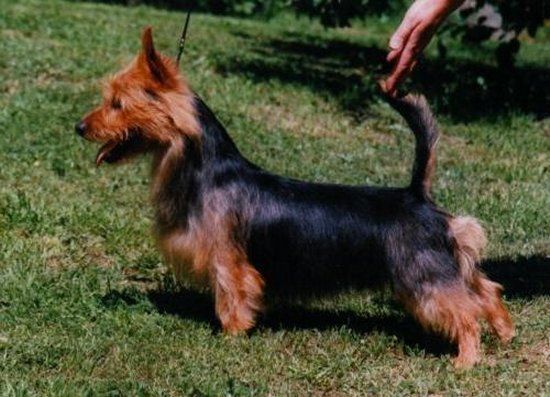
“Galaxy Kid” Ch Selendia Galaxy Kid (Breeder Pia Lindqvist, Owner Jill Grenaae)
Ch Tatong’s Eclipse of the Moon (IntCh Tatong’s Silver Moondancer x IntCh Ibeth Orange Blossom), IntCh Tatong’s The Exorcist (Ch The Farm’s One Hell of a Devil x IntCh Tatong’s Red Orient Ruby) and his son Ch Tatong’s Don Corleone are among my favourites.
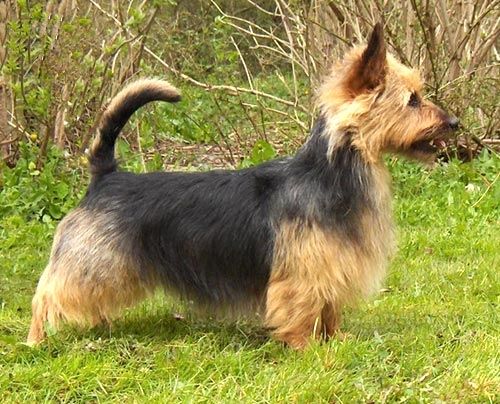
“Sally” IntCh Tatong’s Wrapped in a Riddle (Owner Irene Thye)
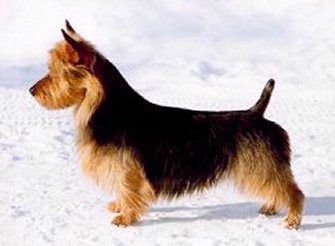
“Konsta” Ch Tatong’s Eclipse of The Moon (Owner Orvokki Lämsä)
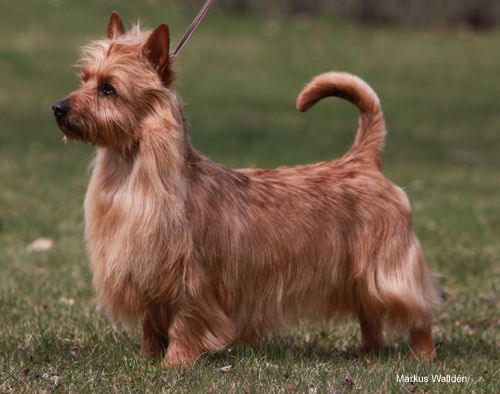
“Leo” Ch Tatong’s Don Corleone (Owner Agnethe & Paul Dietrich)
Photo: Markus Wallden
Two dogs I also want to mention are IntCh Golden Moonraker du Clos de Windorah (IntCh Tatong’s Silver Moondancer x Ch Dare Devil’s Neelah Nyhree)
and Ch Devil in Disguise av Falchebo (IntCh Tatong’s The Exorcist x Ch Tineetown The Queen O’Hearts). I was fortunate enough to be able to have the pick of the litters when I chose these two and they each stayed with us for a year or two until they went to their homes in Finland and Sweden respectively. I am proud of both these dogs that have done wonderfully in the show ring and as studs as well as been great companions for their owners.
I have owned several lovely bitches, special favourites have been Ch Avocation Double Action (Ch Moomba Red Butch x Ch Avocation Red Kamilaroi),
IntCh Selendia Blue Moonshine (IntCh Tatong’s Silver Moondancer x Ch Sinimarjan Abigail), IntCh Ibeth Orange Blossom (Ch Ymsens Yarrangobilly x Ch Ibeth Calypso Queen), Ch Tatong’s Bloody Mary (Ch Tatong’s Red Mustang x Intch Ibeth Orange Blossom), Tatong’s Cruella De Ville (IntCh Tatong’s Silver Moondancer x Ch Avocation Double Action), Ch Tatong’s Fickle Finger of Fate (Tatong’s Inner Circle x Tatong’s The Devil’s Daughter). All time favourite was the litter sister of Ch Tatong’s Red Mustang and Ch Tatong’s Motown Sound. Her name was Tatong’s Red MG. She held no titles, except for that very personal one as my “Once in a lifetime dog.”
Looking at the question again I see that you ask me to mention “a few favourites”….these are perhaps more than just a few, but being used to thinking in pedigrees, the thought of one dog reminded me of another and since they have all been much loved, it is hard to choose.
Who were they and why were they your favorites?
Elaborating on them all will be too much, but my all time favourite is Tatong’s Silver Moondancer. He was a fantastic dog in every aspect. How often do you get a wonderful show dog, a super family dog and an amazing stud dog in one gorgeous package? Having been a breeder for over 25 years I can tell you: “Not often.” Smiley, as he was called, can be found in many, many pedigrees the world over and with good reason. He produced beautiful, sound offspring and I was so fortunate to be able to breed and own a dog like him. Another of my favorites I want to mention is IntCh Tatong’s Wrapped in a Riddle (Ch Bearstep’s Tonganoxie x Ch Tatong’s Fickle Finger of Fate), Owner Irene Thye, Kisamba Aussies. I also want to mention another favorite Ch Selendia Galaxy Kid (Ch Tasdale Kraka Kid x Intch Selendia Disco Dancer.)

Ch Devil in Disguise av Falchebo Photo:Kenneth Holmberg
(Breeder Marte Falch, Owners Jill Grenaae, Tina Nordgren, Ida Nordgren)
How has the Aussie changed since you started breeding?
When I began breeding we sometimes saw some quite nervous and aggressive Aussies, mainly among those not registered with the Danish Kennel Club. This has changed radically over the years and luckily all for the better. More focus is on the dog as part of society and as such more attention has been placed on temperament. Today, thanks to dedicated and serious breeders, the Aussie is considered a happy and outgoing breed here.
Do you think the Aussie has improved?
Yes and no. This is a small breed that is very sensitive to fluctuations. One serious and accomplished breeder can have a huge effect on the overall quality as can, unfortunately, one less accomplished and less serious, so I think that overall a breed as small as ours will have its natural ups and downs as breeders come and go. In general I think that the breed is lucky to have some very dedicated fans and breeders such as the people involved with this newsletter. You have the potential through this media to have a great impact on the breed by educating and bringing breeders together from every corner of the world and that can only benefit the breed.
What concerns you about the Aussie of today as it relates to conformation and health?
Temperament is always a concern of mine. Please, please breeders, do not just look at pretty pictures on web sites, but get to know the dogs you choose to breed from.
Another concern is of course diabetes. Most cases of diabetes in the breed seem to be type 2 with late onset, but as one breeder of Welsh terriers once remarked when we were discussing this: “Many Welsh Terriers live to 14 or older and hardly any get diabetes.” Diabetes is a problem in Aussies and it is great to see that some breed clubs choose to support research into this.
With regards to conformation, I think the breed, like SO many others, could benefit from breeders being more focused on fronts and overall movement. An Aussie should have sufficient upper arm, a good layback of shoulders and a keel/forechest. It should NOT have a “leg in each corner.” If the front assembly is correct, the dog will also have a nice flow of neck into shoulders instead of a marked 90-110 degrees angle of neck to shoulder, and the movement will be nice and floating.
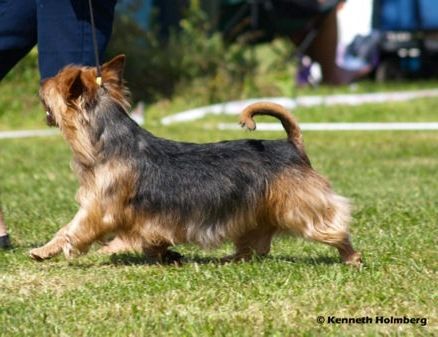
Ch Devil in Disguise av Falchebo Photo: Kenneth Holmberg
Illustration of how correct anatomy translates into correct movement.
Finally I think we see many dogs that could be better proportioned. Many are very long and very low – I have bred a few myself.
What have Aussies added to your life?
First and foremost the Aussies have added many wonderful contacts and friendships to my life. It may sound strange to mention this before the joy that the dogs themselves have obviously brought, but dogs have a short lifespan however much we wish it were different. Never-the-less almost every one of the dogs now gone have resulted in a great friendship with a breeder and/or owner; to me that is the greatest addition the Aussies have made to my life.
In 2007 we saw the birth of our last Aussie litter and in 2009 we handed in our kennel prefix Tatong. Besides Aussies we had then, for a couple of years, also been breeding Labrador Retrievers and since I had become more and more involved with training and doing field work with the Labradors, I realized that I just could not breed both Labs and Aussies; it was simply too much work having both breeds. Also the many years of grooming has taken its toll on my hands and shoulders, so all in all it seemed like the right time to let go. We now have two 9 year old Aussies, Ella and Victor, that will probably be our last, but after more than 25 years of breeding I think I am allowed to say I have done my bit. Besides, there are so many skilled and clever breeders out there who do great work with their Aussies and it makes me confident this breed is in very good and capable hands.
|
| Photos from Bethina Gade, Denmark |
|

“Bastian”

“Bastian”

“Bastian” enjoying agility!

“Terry” enjoying the snow!
I grew up with Dachshunds and Tommy with Cairn Terriers. Tommy and I decided to get our first dog 4 1/2 years ago. We totally lost our hearts to the Australian Terrier. We read and learned about the breed and it seemed to be a good fit for our lives. We also spent a lot of time speaking with our breed representatives and learned more about the breed before we finally decided to buy an Australian Terrier.
We bought our first Australian Terrier, Santomay´s As Good As It Gets “Bastian,” in November 2007. We got him from Santomay Kennels in Norway. From that day on our lives changed as “Bastian” became a big part of our daily lives. We trained him in obedience and for conformation. We also played with him a lot and took him for very long walks every day.
Approximately 2 years after buying “Bastian,” our breeder (Santomay) told us they had a 10 month old Aussie male. I fell in love with him and agreed with our breeder to buy him. His name is Santomay’s Catch Me If You Can “Terry.” Now we had 2 dogs, “double trouble,” as we call them. Both Tommy and I are very interested in this breed and we do love them so much. Both dogs are a big part of our lives and we have so many wonderful experiences with them. We also meet so many nice people when we are training and at dog shows. We actually miss the dog shows and the other Aussie owners when there is an activity break during the summer and at Christmas.
I think we did well at training and at the dog shows. However, and most importantly, it is always the same dog we bring home. Win or lose, we enjoy the dogs so much. We dream about using both dogs for breeding someday and having more Aussies. We are both quite sure that the Aussies will be a part of our lives for a very long time.
Regards to everyone from Bethina and Tommy |
| Aussies in Denmark by Irene Thye, Kennel Kisamba |
| In 1953 the first Aussie came to Denmark, Countess Lise Molkte got Neneside Kursaal, “Digger” as a present from the Duke of Gloucester when she visited the United Kingdom. Later on the Countess imported Elvyne Blue Tango from Levine Kennels in the U.K. These two Aussies were the beginning of the Danish breeding of Australian Terriers: “Kennel Treffi.”
Later on other kennels started breeding f.eks: Kennel Tjoernely, Kennel Tungehave, Kennel Sparius, Kennel Ravnegaard, Kennel Mariendal , Kennel Tippe, Sam-Zu, Ibeth, Tho-li, Lille Regina, Tatong, Borchorst and Danschaefer.
In 1973 Kennel Mariendal (Betty Bryde) imported the first red Australian Terrier “Ilukas Tammi Do” from The Netherlands.
This is a list of kennels in Denmark that have been active for more than 10 Years according to the DKK database:
Kennel Mariendal, Tungehaves, Tippes, Sam-Zu, Ibeth, Tholi, Lille, Regina, Tatong, Katonga and Kisamba.
In 2011 The kennels registered as active:
Rumle – Kurt Andersen and Jette Rybak
Kisamba – Irene Thye
Blue Ayers – Jorgen Gronlund and Deborah Sommer
Chatham – Minna Chatham
In Denmark, Australian Terrier owners are part of the Danish Terrier Club (DTK). All breeds have their own group and they select a Breed representative, who again chooses an assistant. In Denmark we don’t have an Australian Terrier Club, we have an Australian Terrier Group. (I’m the Breed Representative and Joergen Groenlund is my assistant.)
DTK arranges all the Shows such as obedience, rally, and agility. If we want to have separate arrangements for Australian Terriers such as grooming courses, shows just for our breed, activity days, or seminars, we arrange it ourselves. Our finances are separate from the DTK but we have to report to the DTK.
For many years we’ve had grooming courses close to where I live every spring and we try to arrange courses in the east part of Denmark as well. I don’t know why but the interest is bigger in Jylland and Fyn.
Every year we have our Activity Day and we all really enjoy the day!
We all have breakfast together and following breakfast we have 12-14 fun competitions (games) for the dogs.

Some of these competitions are:
1. Potatoes on a spoon
2. Sack race with the dog
3. The dog has to run under a “human bridge”
4. Jump – adult dogs both ways -puppies only one way
5. Ladder – the dog has to walk where the ladder is
6. Slalom in between the participants both back and forth
7. Treats in a small bucket or tube (has to be tipped to get the treat)
8. Dress the dog in a T-shirt
9. Going out dogs jump covered barriers-on the way back they go through them 10.Tunnel – adult dogs both ways – puppies only one way
11. Butter tubs with treats
12. Balance over 4 chairs
13. Stand on owner who is laying down
14. Stand on the back of the owner on all four legs
15. Stand on the shoulders of the owner
Following the games it is possible for the dogs to try tracking and agility. Finally later in the afternoon we have a barbecue party and at this point all the Aussies are tired and ready to relax.
|
|
Population and Health by Jorgen Gronlund of Kennel Blue Ayers
|
| The Aussie population in Denmark
The breed had the largest number of registered pups in the 1980´s, but the Aussie has never been a trendy dog in Denmark, and the number of registrations has never been astronomic.
Beneath you can see the number of DKC registered Aussies over the last 32 years.
The imports, approximately 3 per year, are included.
The Danish Kennel Club has introduced a recommendation concerning inbreeding,
represented by the so-called inbreeding coefficient. This coefficient should not exceed 6,25%, which corresponds to a first cousin mating. The Danish Kennel Club has a database, which includes, of course, pedigrees, health info etc. of all registered dogs. Here you can enter a possible mating and the program will tell you the exact inbreeding coefficient.

Health
Our experience regarding health is based on collected information from present and former breeders along with knowledge from the contact we have with a large number of Danish Australian Terrier owners.
Among the diseases that occur in Denmark we can mention diabetes, patella luxation, Calve-Legg-Perthes, Cushing’s disease and allergic reactions (i.e. due to flea bites.) We also see runny eyes (this could be due to lack of trimming of the hair around the eyes or to entropion.)
Today you cannot really say that any of the diseases mentioned appear on a larger scale. Some years back we had a number of diabetes cases, but at present we hardly see any. However, in dogs as well as in humans, lifestyle diseases have appeared. We do occasionally see diabetes 2 in obese dogs from the age of 6-7 years.
Since there is no official register of inherited diseases within the breed, it is difficult to give a detailed picture of their frequency.
|
| Artist Betty Bryde |
| Betty Bryde was a long time Aussie breeder in Denmark. As an artist she frequently captured the beauty, regalness and spirit of the Aussie, in her many fabulous pieces of art. We are including six of Betty’s works with her permission.
Her work has a copyright and you must write to her for permission to reprint.
Betty also wrote and illustrated a book, entitled, “Australsk Terrier” which was published in 1977 by Clausen Press. The book is out of print, but available in libraries. If you are lucky, you can still find the antiquarian.
The book is 55 pages and covers topics such as breed, breeding, diet, grooming and exhibition. The book is illustrated with many photos.
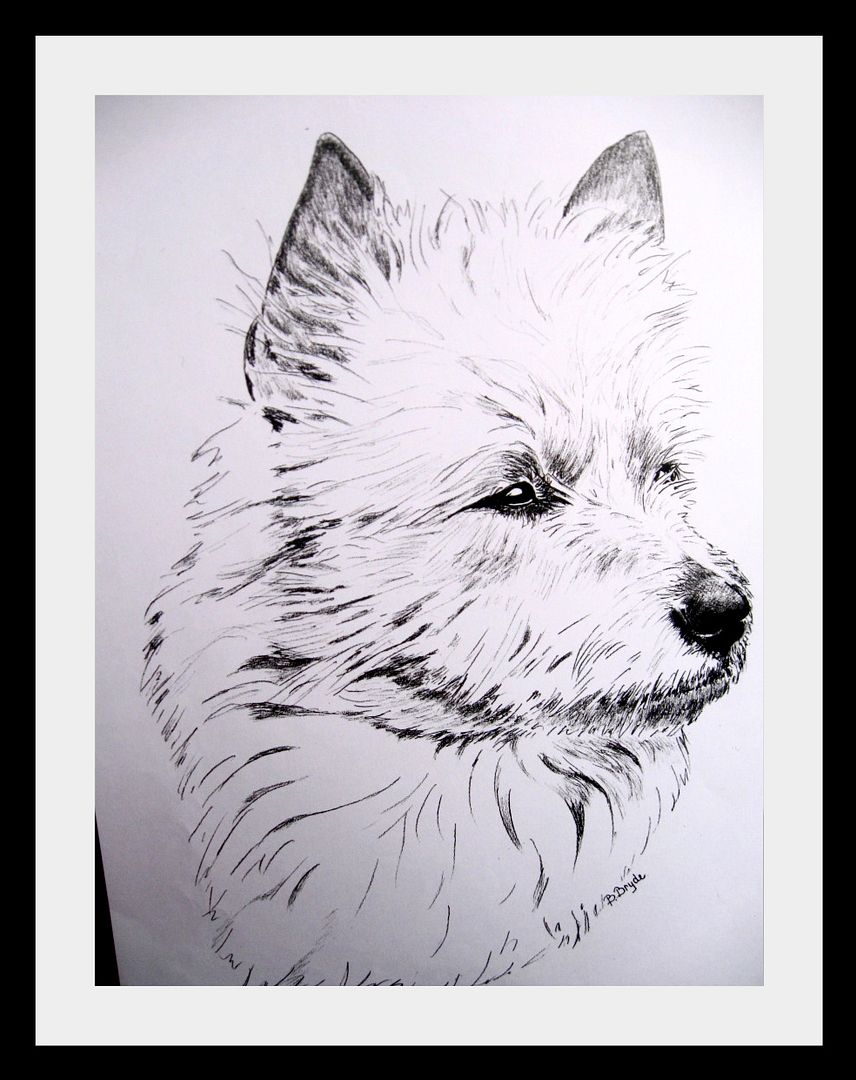
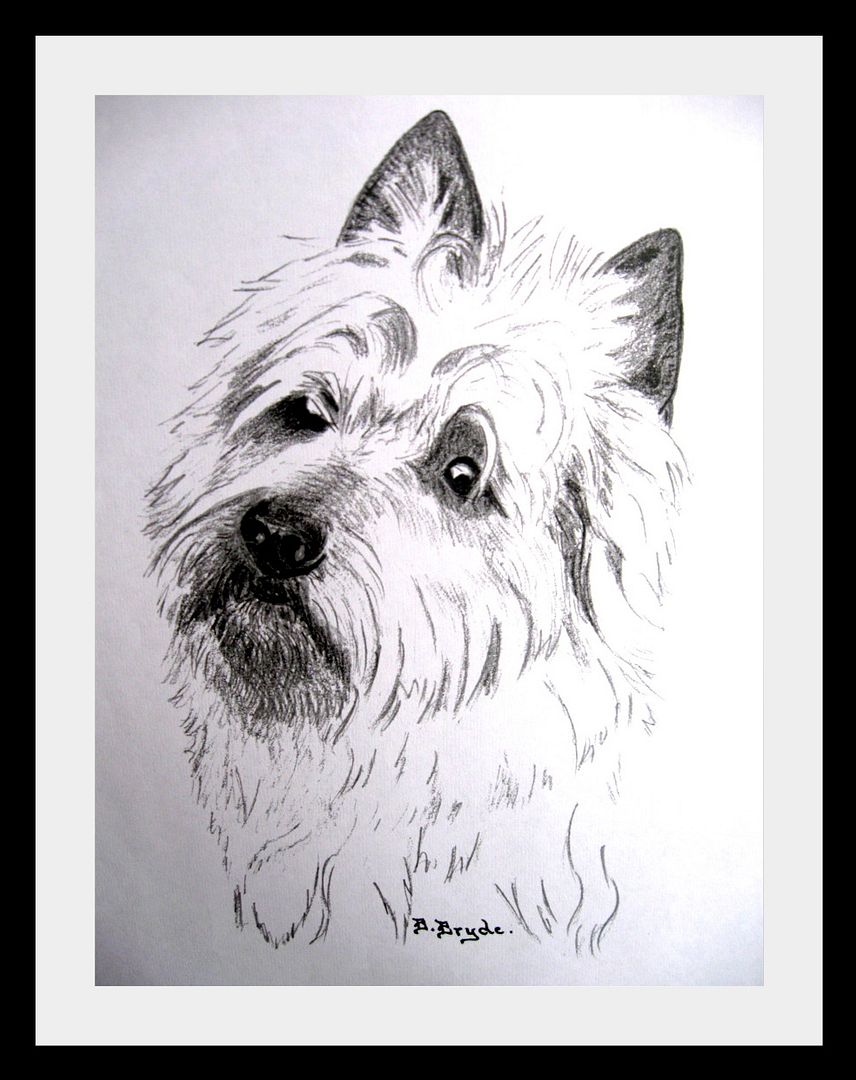
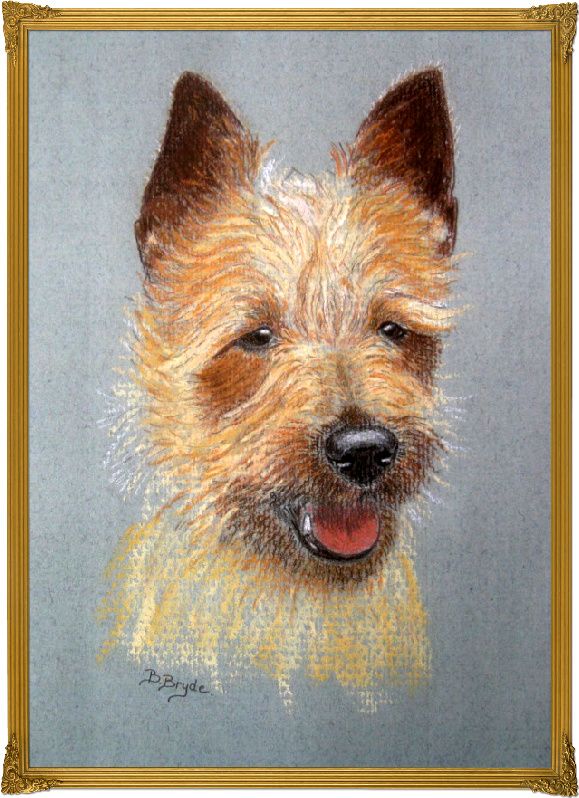
Thank you to Jorgen Gronlund
for taking the time to go to Betty’s home and to photograph her art for us to enjoy!
|
| An Interview with Irene Thye, Denmark |
|
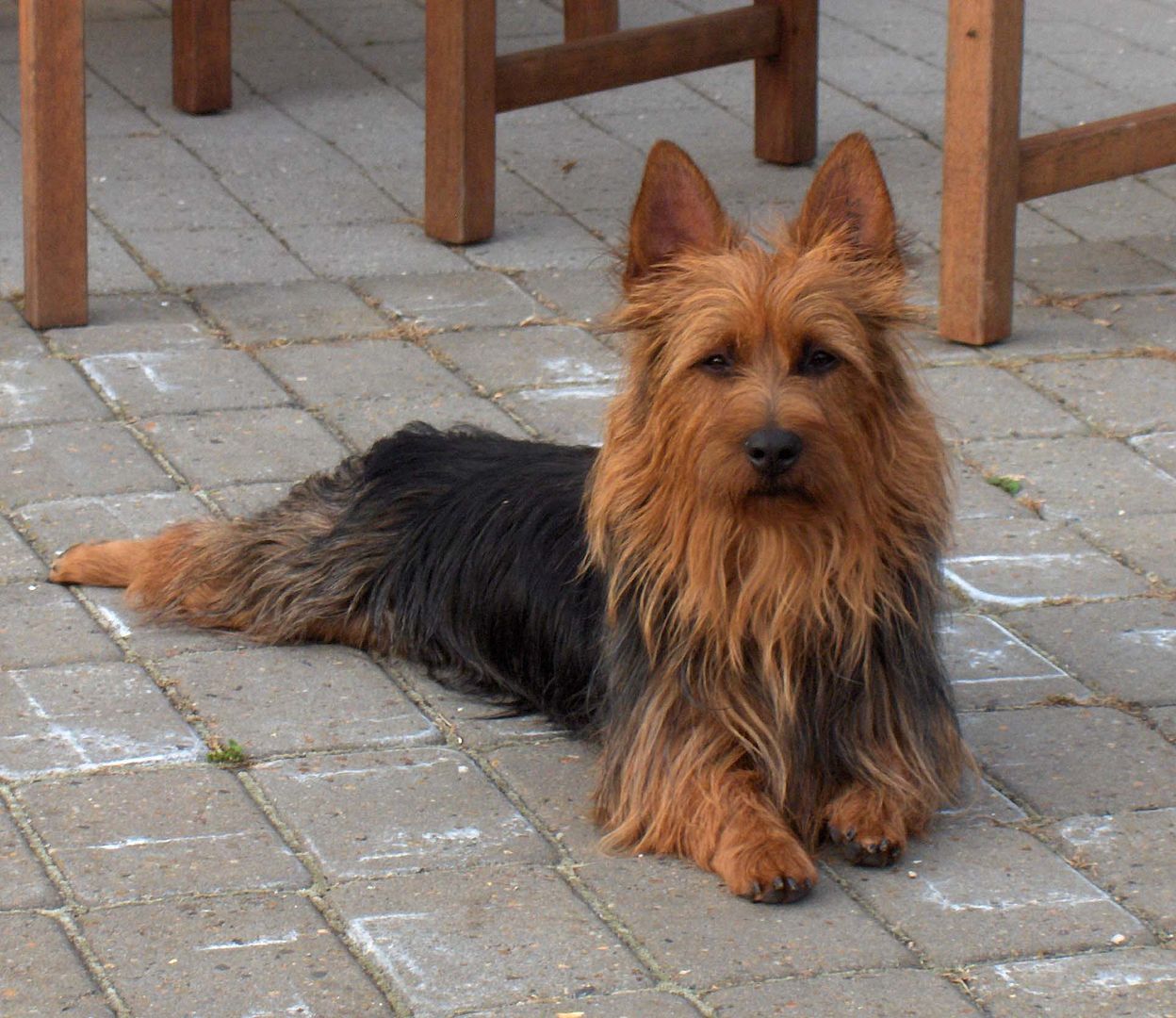
How did you become interested in Aussies?
During my childhood our family had cats. It was not until I was married that we got our first dog. My husband, our eldest daughter and I lived for some years in Tanzania and it was here we got our first dog; it was a proper “Tanzania breed”.
For our family it was a lovely dog though it was clearly racist. Whenever a native came to our house or just passed the house it went nuts. Regrettably, when we
left for Denmark, we had to leave the dog with some neighbors.
Having settled in Denmark again, we bought a dachshund. Unfortunately, at the age of only 4, it had a slipped disc and we had to have it put away.
After losing our dachshund we started studying books about dogs in order to find out which breed we should choose. We focused on finding a breed without any breed specific diseases such as the slipped disc with the dachshund. It was a terrible situation living with a completely paralyzed dog that was only 4 years old. We are all still deeply touched by the memory. We all agreed that we did not want a big dog and that it should be friendly to guests and especially children. The dachshund had caused some concerns when our girls celebrated their birthdays and we had had to keep it separated from the children. We were afraid it might snap at some of the playing children. This dog also ran away whenever it got a chance and it did not return home until it felt like doing so. We found this very nerve-racking. We crossed our fingers each time it ran away hoping it would not get run over in the traffic.
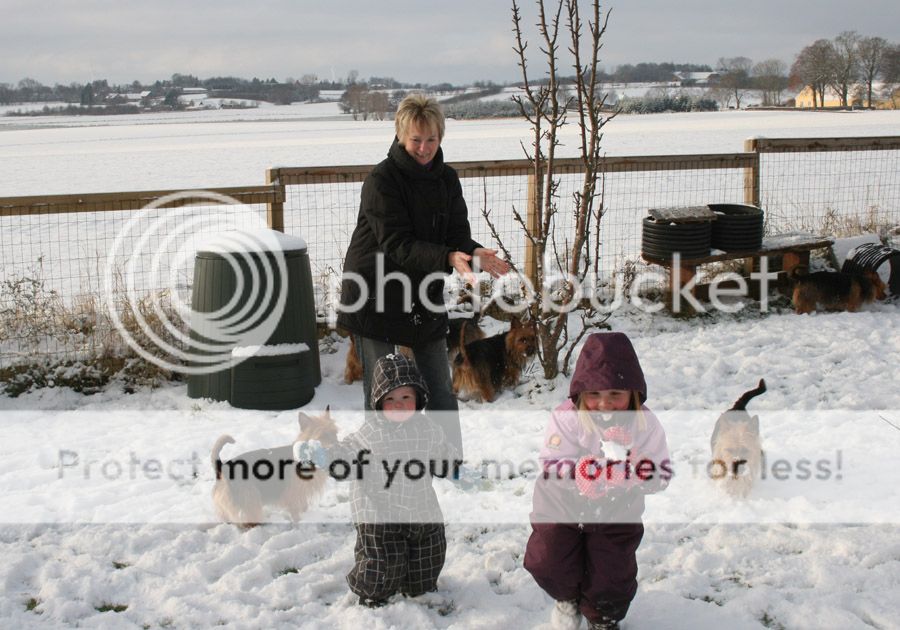
We visited a dog show looking at some of the different breeds and we were keen on the Westie, which was very “in”. However, in the next ring the Aussies were showing and the “Grand Little Dogs” charmed us and we went to talk to some of the owners. After the Aussies had been shown we contacted Jill Grenaae and after talking to her we decided that our next dog would be an Aussie, something we have never regretted! We bought “Mikki” from Kennel Tatong and our eldest daughter started training the dog for obedience and show and together we started participating at dog shows.
With the Aussie we found a loving family dog. They simply love guests and enjoy playing with the children. Our Aussies enjoy everything from playing football to catching soap bubbles. Normally we do not have any problems with our dogs running away. Ours like to stay close to us, keeping a close eye on our every movement.
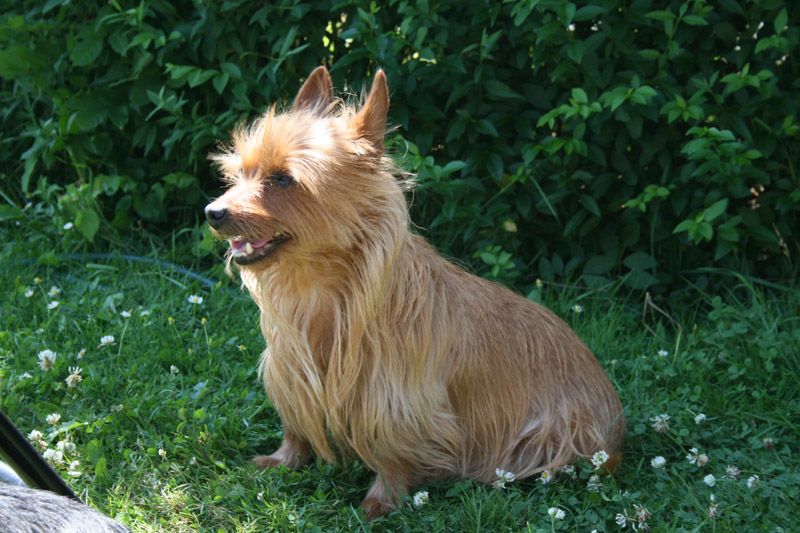
What was your first Aussie?
Of course “Mikki” was the best Aussie in the world. Our girls simply loved him and enjoyed having a playful dog compared to the dachshund we had earlier. Very soon after having “Mikkie,” a 1 1/2 year old Aussie girl “Sisse” moved in. Our girls started training the dogs in obedience and show training. “Mikki” they showed until he was DKCH (A Danish Champion).
Agility caught my interest and I started training and participating in competitions with Mikki. When we started agility some of the instructors asked me why on earth I had bought an Aussie. They had bad experiences with Aussies and their tempers. Very soon after working with “Mikki” they all loved him and I never heard anything about Aussies having “bad tempers” again!
Sadly “Mikki” died at only 4 1/2 years old. He suddenly became very ill and an X-ray showed a foreign body in his stomach. He underwent surgery and had a peach stone removed. Unfortunately it had perforated his intestines to such a degree that he did not survive surgery. We nearly cried our eyes out! He was buried in our garden and his grave was nicely decorated with flowers.
We were lucky and were able to get a lovely puppy from Jill’s next litter.
Later on I became an agility trainer and brought more of our Aussies to agility training.
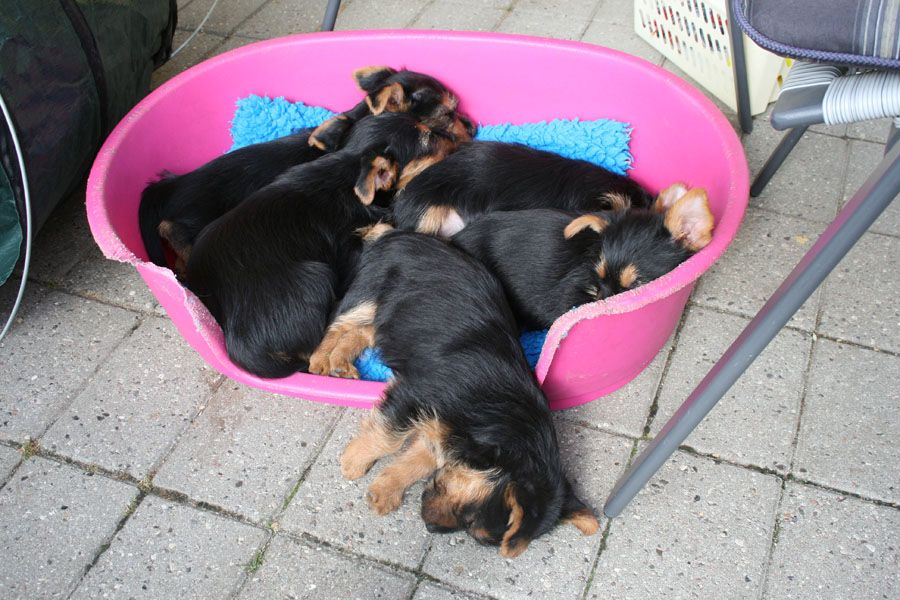
Have Aussies changed since you started breeding them?
Well the size of the Aussie has been going up. In fact very few of the Aussies are the size listed in the standard. I guess we’ll have to work on that problem.
At some shows the Aussies are very different in type. Anyway I think the quality of the Aussie is pretty high and focus on health is improving.
Mentally the Aussie hasn’t changed; it is still a loving and active dog.
What do you think we need to look at, internationally, to improve the breed?
To improve the breed, it is necessary to strengthen the connection between breeders. We need to have more transparency with regard to diseases and weaknesses in the breed so we can improve our breeding programs. I think that ATI will allow for better cooperation across the borders. By getting to know each other, breeders can have a better chance at making really good breeding arrangements.
Do you work with the European Community to strengthen the Danish breeding programs and do they work with you to strengthen theirs?
The DKK and DTK do a great job of continually strengthening breeding programs. Denmark lacks a system to register diseases in each breed but hopefully it will soon be possible.
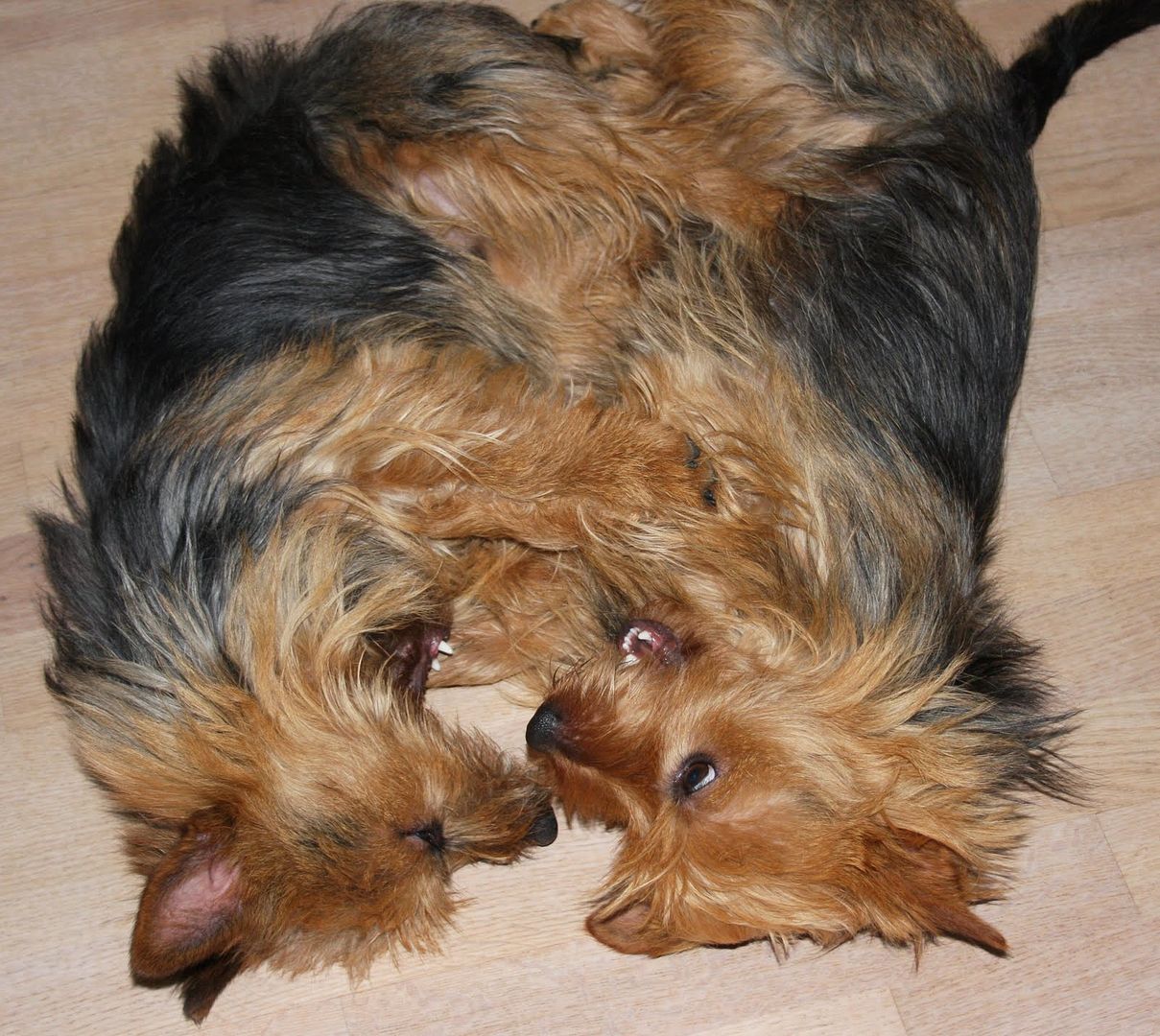
Can anyone breed their Aussies or do the dogs and bitches need to be approved prior to breeding?
The breeder has to be a member of the DKK or DTK to have the puppies registered. The dogs have to be awarded at least a Very Good but they need not be championed.
It’s legal to have two litters without getting the Kennel registered but after that the breeder has to participate in a breeder education and the DKK will inspect the Kennel.
We have to follow the DKK restrictions:
AUSTRALIAN TERRIER
Race Number GBP: 0080
Group: 03
Special Club: Danish Terrier Club
The breed has the following breeding restrictions:
Award Requirements:
Offspring can only be registered if the dog, before mating, is awarded a Very Good at a FCI/USD recognized exhibition beginning 1.1.2011 or it may have obtained breeding approval at a breeding approval scheme arranged by the race’s special club and approved by USD. Breeding restrictions were introduced January 1, 2009 and cover the entire breed.
HD General Information:
You do not have to get your dogs hips checked in this breed.
Applies to all dogs in the breed after the first January 2005.
As a breeder you also have to follow DKK’s ethical recommendations:
A bitch should not be bred before her 3rd season. If she has puppies in two following seasons she can’t be bred in the following. The number of litters for a bitch should not be more than 4, maximum 5, and the last litter should be born before the bitch is 8 years old.
Breeder Education:
Theory Modules
This program includes 6 theory modules, which involves more than two teaching days. Theoretical instruction is conducted both on weekdays and weekends to make participation as flexible as possible in relation to farmers’ lives.
Theory modules are held both on Zealand and Funen and in Jutland.
The program includes the following theory modules:
*Kennel Interior
*Genetics
*Health and Puppy Births
*What must, should and do I need to puppy buyers? (Guidance obligation Sale of Goods Act, etc.)
*USD’s mental description and the dog’s mental development
USD and the World Classes are taught by trained kennel consultants, behavioral consultants, veterinarian, and legal gains. On each team there is a “breeder host” (an experienced, reputable breeder) who is the liaison between teachers and students in all theory modules.
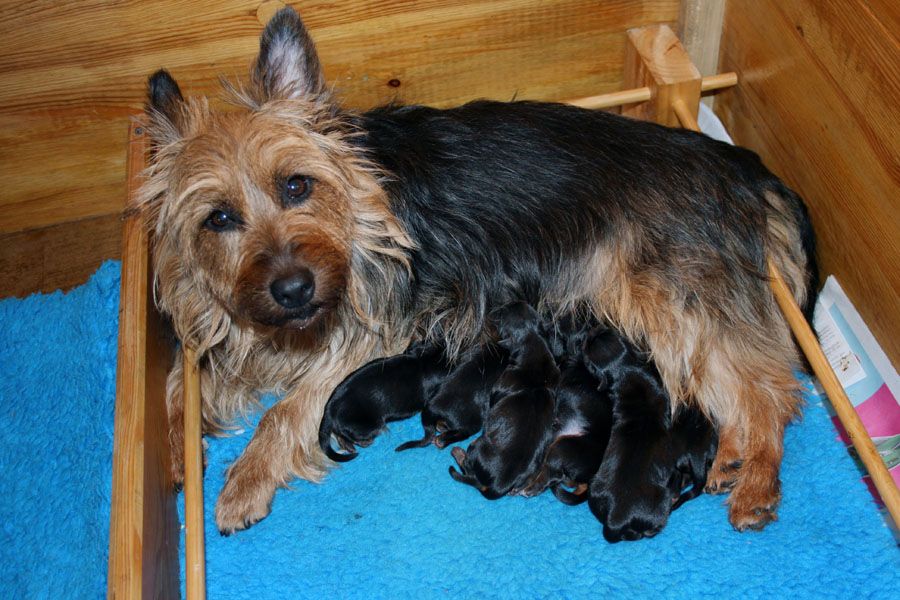
Would you like to see the number of Aussie owners and breeders in Denmark grow?
I would love to see the number of Aussie owners and breeders grow. Denmark is a small country and after several years with very few litters and puppies to sell, we had more puppies in 2010. Some new breeders did not succeed in selling their puppies and possibly the economic crisis gave them some problems. We have had people breeding “Aussies” without pedigrees and selling them for 3/4 of the price of a registered Aussie.

How is the Aussie regarded in Denmark? Is it a very popular dog?
A lot of people still do not know the Aussie. I’m often asked what breed it is. However, when I meet people who know the breed they love to tell me about the Aussie they owned in the 1960’s or the 70’s. It leads me to believe there must have been a lot of Aussies in Denmark, years ago. Many of the families who buy an Australian Terrier now, have either had an Aussie earlier in their lives or known one.
Will you be attending the World Show 2011 in Paris?
Hopefully I will attend the WDS 2011. We look forward to being able to relax and concentrate on the Aussies and not be left with the responsibility of the event. I am looking forward to meeting everyone again!
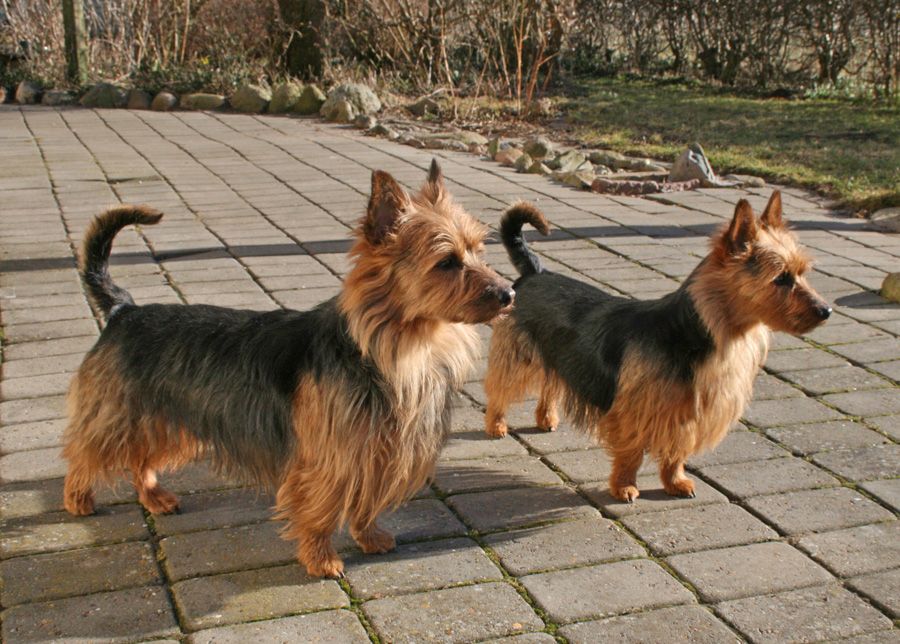
Do you feel ATI is beneficial to the Aussie breeders in Denmark?
Yes indeed I do! I am enjoying the newsletters very much. Thank You VERY MUCH for all the work you all do!
What I find particularly useful is that I find some of the breeders don’t have websites and I can’t find photos of their dogs. Sometimes I get lucky and find the photos of a certain dog either on the ATI website or in the ATI newsletters. It is a great resource.

All Photos in this article Courtesy of Irene Thye.
They may not be reprinted without her permission.
|
| Betty Bryde Art Work, Denmark |
|
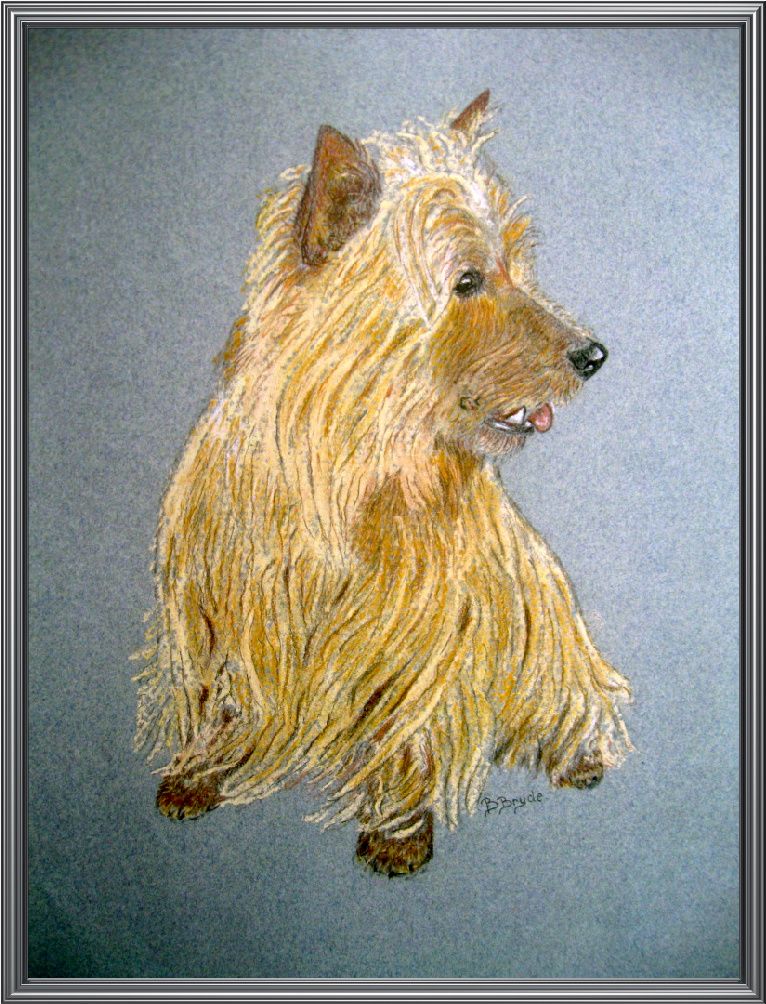
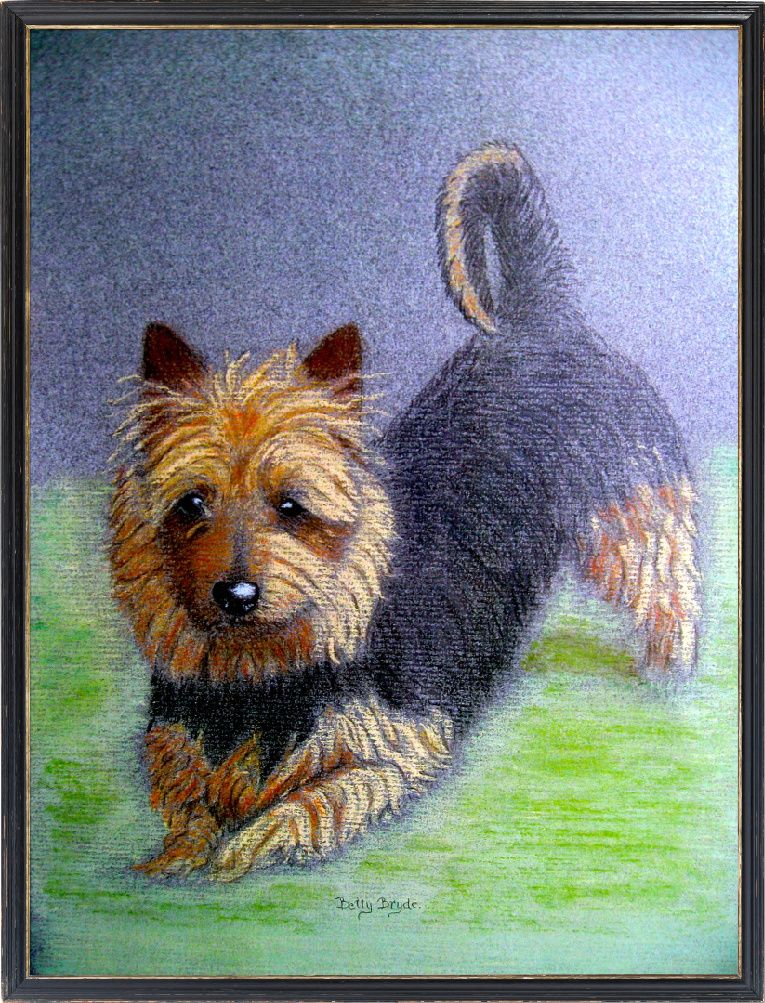
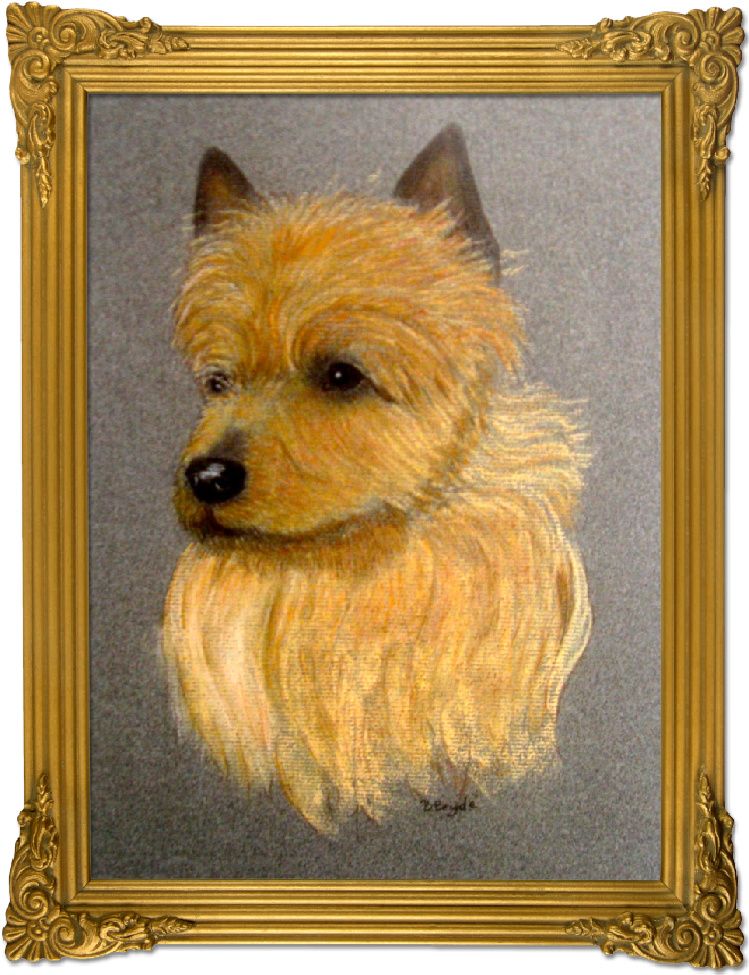
All images are copyrighted to Betty Bryde and may not be reprinted
without her permission.
|
| World Dog Show, Denmark 2010 |
| If one decided to enter the World Show, it was possible to enter Aussies in two additional shows, thus three shows in total, The World Dog Show (WDS), The Terrier Specialty (TS) and The Aussie Specialty (AS).
The WDS was in Herning and had 64 Aussies entered, the TS was held in Hedensted and had 18 Aussies entered and the AS was in Hedensted as well with 28 dogs entered. We felt it was unfortunate that the TS and the AS charged the same, very expensive amount for show entries, as the World Show. With the current economy many people had to pick and chose which dogs they were going to choose and at which locations.
We very much enjoyed the large number of Aussies entered in the WDS, which gave us the opportunity to see the best Aussies in Europe, all together. Overall we thought the quality of the dogs was very good. It certainly gave us a lot of new input as to our breeding programs. This is very important in such a relatively small breed as ours and especially in Denmark where we constantly have to import new genes in order to enlarge or at least maintain our gene pool.
The judge for the WDS was Wayne Burton from Australia and of course it is a pleasure to have a judge from the homeland of the Aussie.
The Aussie Specialty was arranged by the Aussie group under The Danish Terrier Club with a lot of help from The Terrier Club. We are a small group with very few people to take care of the show. We were so happy that people from the Aussie Group in Denmark joined us and worked hard to make the show a pleasant experience for the participants.
We had asked Dianne Ivey from Canada to judge the specialty and we really enjoyed having her “new set of eyes” looking at our European Aussies. We felt we could learn from her critiques.
Following this show, we had invited the exhibitors and visitors to a banquet arranged by the Danish Terrier Club. Most of the participants, visitors and judges joined us at this dinner and we managed to get all the Aussie people, almost 40 of us, around one table. It isn’t often that you have the opportunity to talk to Aussie people from all over the world. Sweden, Finland, Norway, Latvia, Germany, Canada and USA were all represented and it was our impression that new friends were made and old friendships were cultivated.
The last show was the Terrier Specialty, which was judged by Susan Hewinson from Australia. Below is a picture of the BOB prize from the Terrier Specialty.
Jorgen Gronlund
I had the pleasure of attending the World Show in Denmark. I think all of us who attended felt so warmly welcomed. Everyone was warm and friendly and even the dogs all got along. We all shared grooming tips and our hopes, dreams and aspirations for the breed. What a lovely time it was. I think all of us who were visiting can never thank everyone enough for all the hard work it took to host both the shows and the foreign guests. Pamela Levy
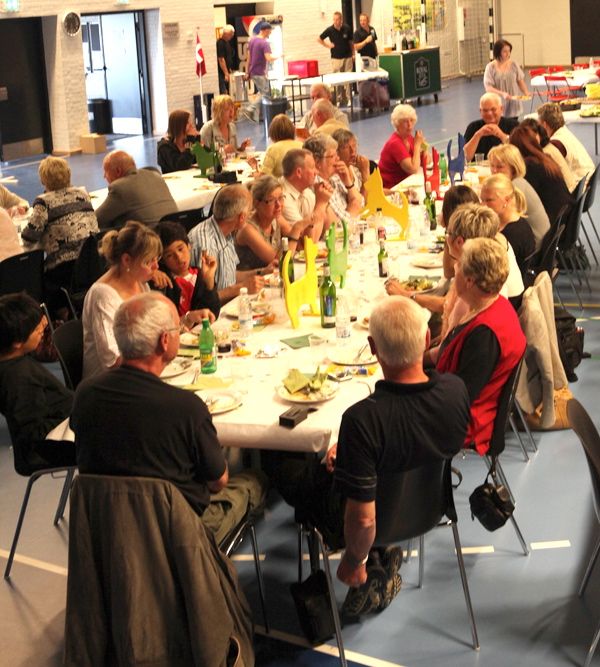
The two days following the World Show, there were Terrier Specialties that took place in a different location. Following the Specialty there was a lovely dinner.

Terrier Specialty
Terrier Specialty Winners
Kisamba’s Bluey Louis (BOB) and Kisamba’s Hot’n Sweet (BOS)
Both are dogs bred and raised in Denmark! (Photos Below in Stats)
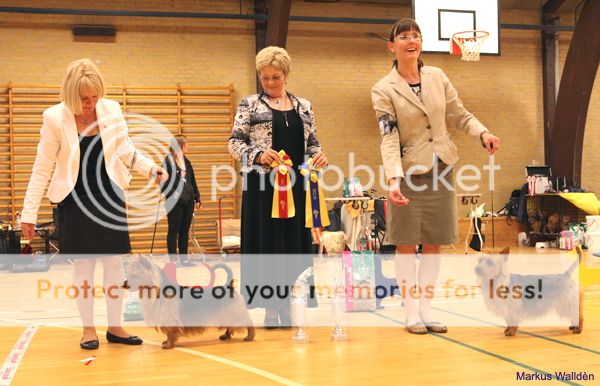
The Winners at the Aussie Specialty Photo By Makus Wallden
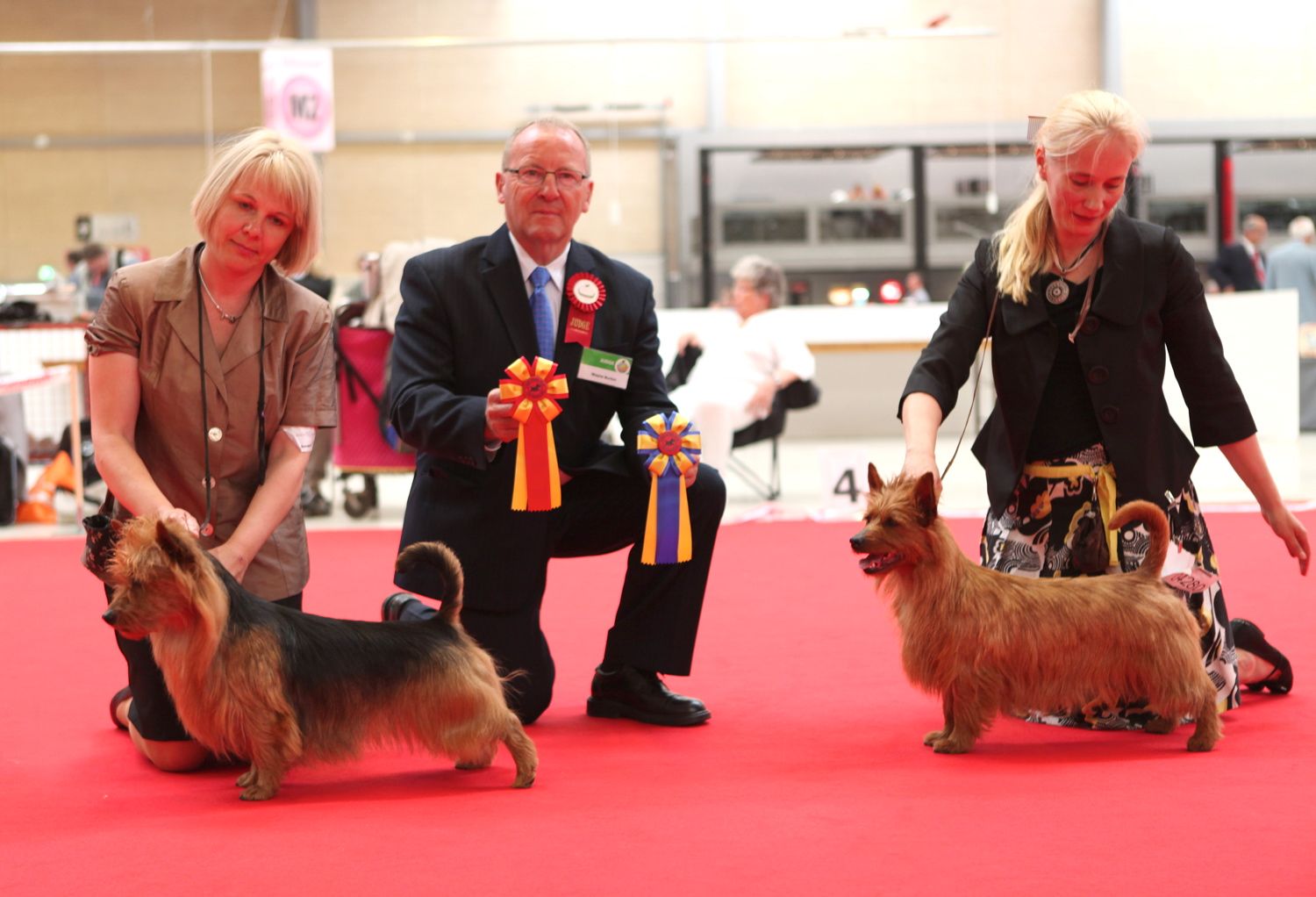
The Winners at the World Dog Show
|
Stats, Denmark 2010
|
|

#1- Kisamba’s Bluey Louis “Louis” (Male) Owner: Jorgen Gronlund 874 Points
www.blueayers.dk
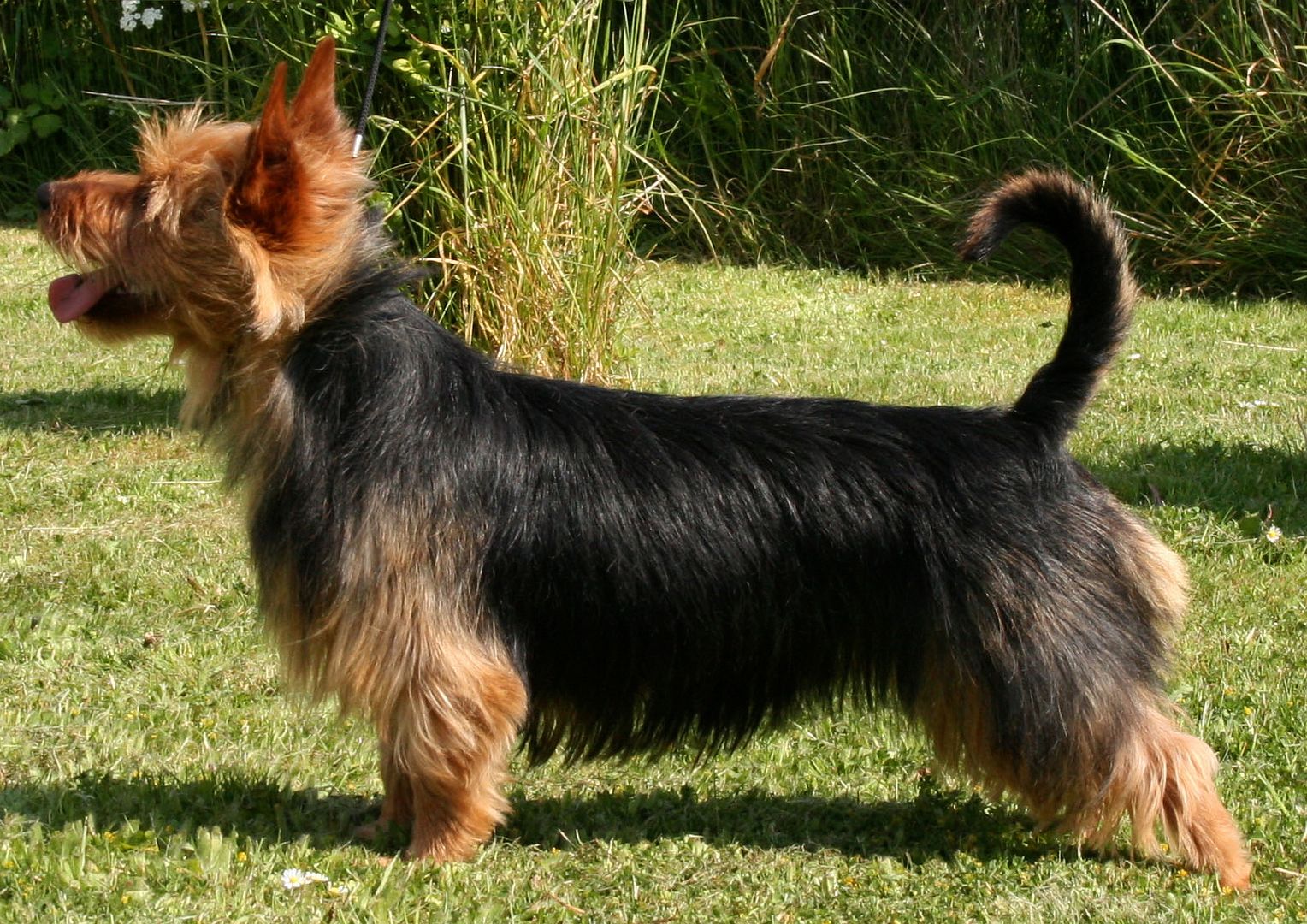
#2- Kisamba’s Hot’n Sweet “Vicky” (Bitch) Owner: Irene Thye 404 Points
http://www.kisamba.dk/

#3- Kisamba’s Sparkling Dream “Enya” (Bitch) Owner: Irene Thye 228 Points
http://www.kisamba.dk
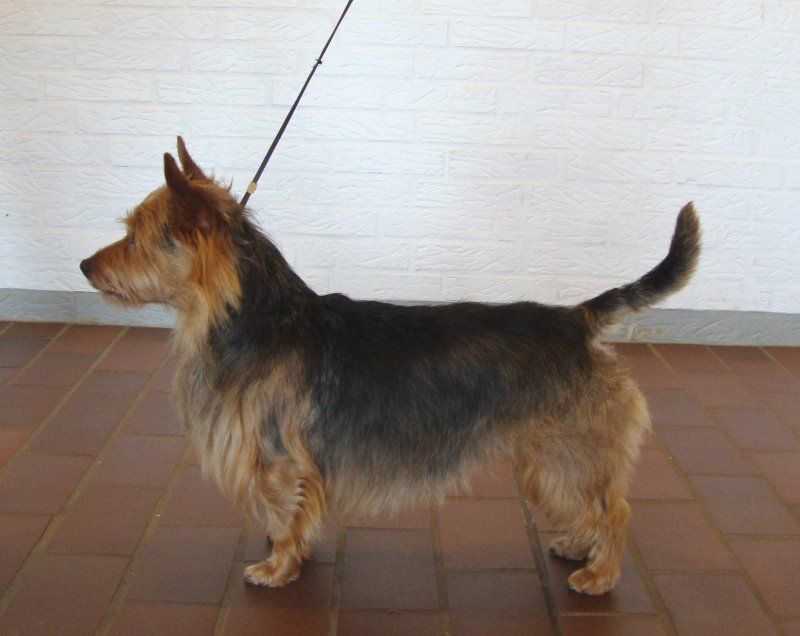
#4- Santomay’s As Good As It Gets “Bastian” (Male)
Owner: Bethina Gade 221 Points
http://www.123hjemmeside.dk/Bethina-Tommy

#5- Tatong’s Barnaby Bear “Barney” (Male) Owner: Minna Chatham 208 Points
http://www.chatham.dk/

#6- Kisamba’s Sparkling Cocktail “Simba” (Male) Owner: Irene Thye 187 Points
http://www.kisamba.dk
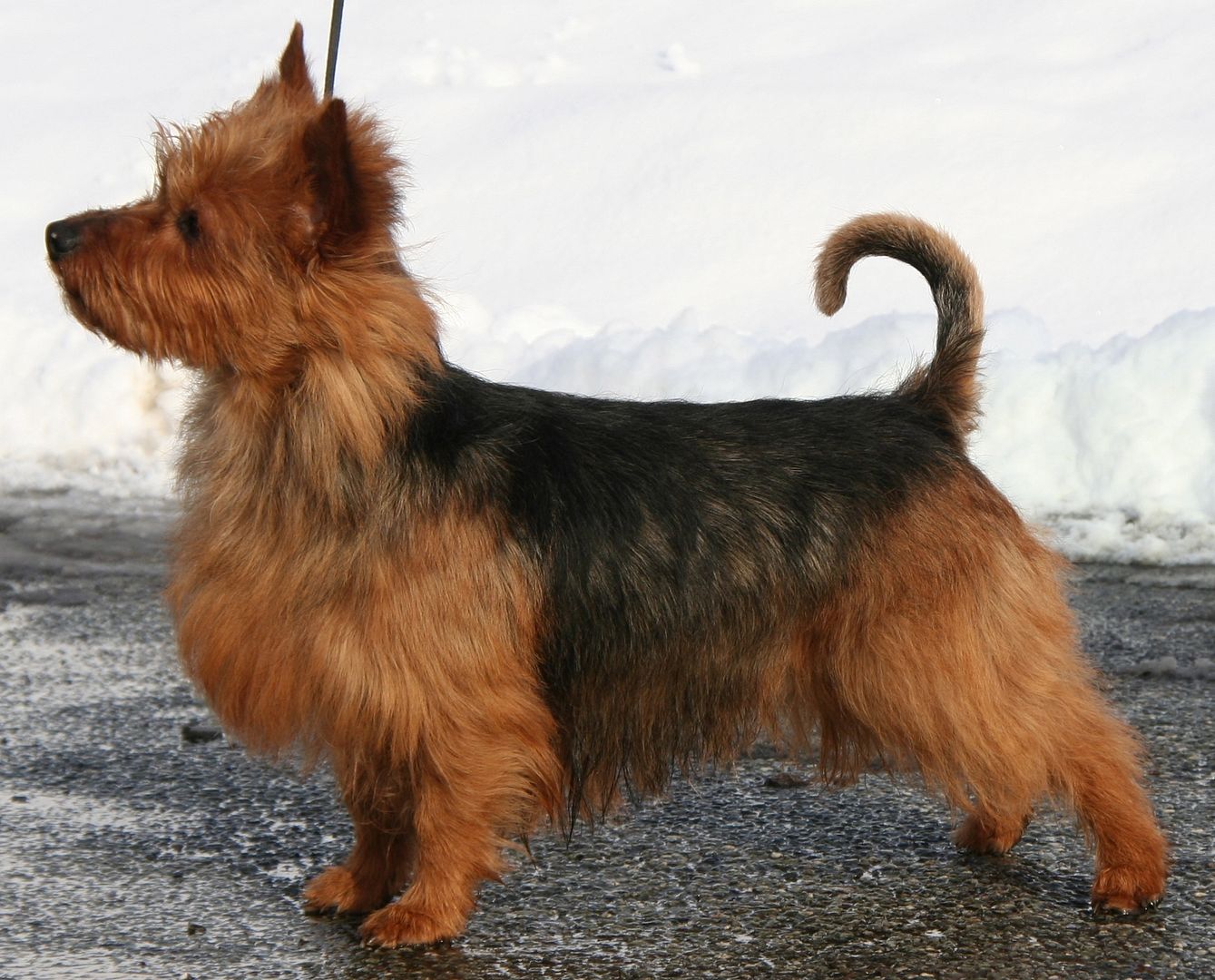
#7- Tanamiers Port Salut For Me “Patrick” (Male) Owner: Marie Kjonaes 152 Points
http://www.santomay.com/

#8- Avocations Lights Of Moon “Luna” (Bitch) Owner: Jorgen Gronlund 143 Points www.blueayers.dk

#9- Surely Nothing To Lose “Silja” (Bitch) Owners: Birthe & Ole Buch 131 Points
http://www.australsk-terrier.com/

#10- Santomay Ariel Blue Angel “Ariel” (Bitch) Owner: Marie Kjonaes 104 Pointshttp://www.santomay.com/
|
Ronja’s Adventure By Marianne Elmgren
|
|
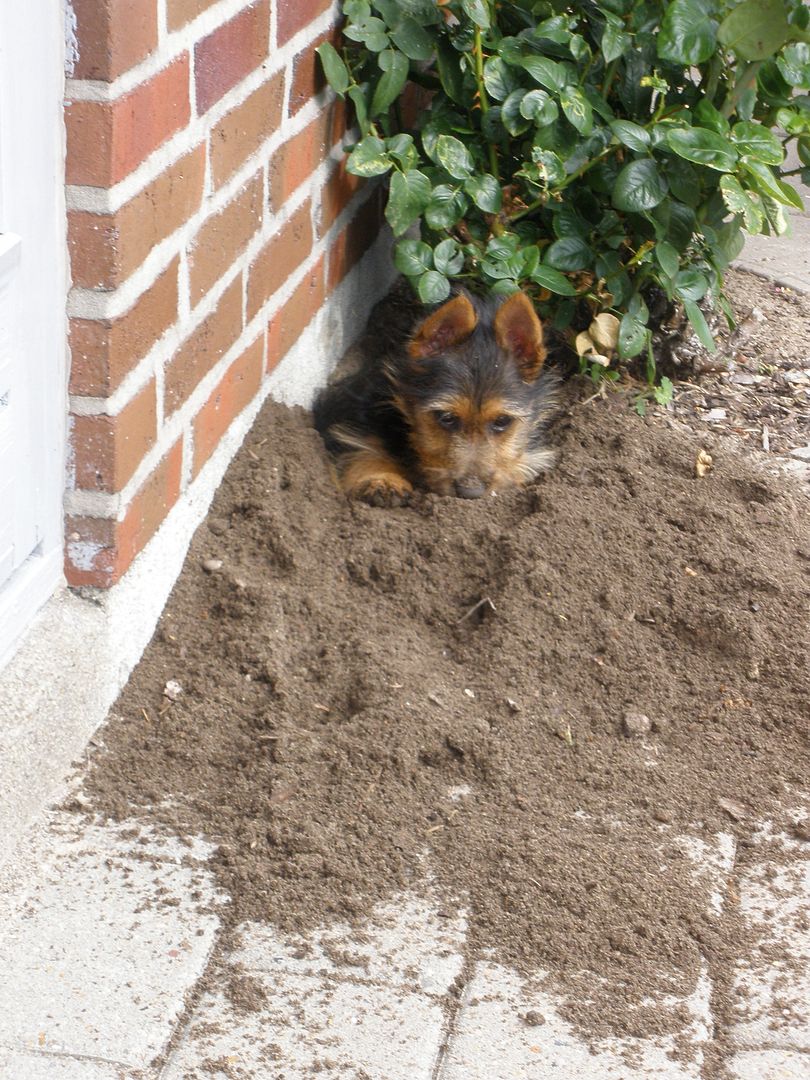
Young Ronja
This is the story about the summer when my Australian Terrier, Nellyson’s Oop’s Me And The Mouse, proved that she is so much more than just a pretty face.
At the end of July, 2010, my daughter, Amalie, and I, along with our two year old Australian Terrier, commonly known as Ronja, went to Sweden. It was my plan that Ronja would be trained to chase out a fox or badger from underground and if all went as planned for her to pass the required test for this. While in Sweden we would have the chance to train our dogs with wild boars and “walk trail,” but I was most interested in the badger part.
The training passes were selected the next day. Everyone participating drew a number which showed when would be their turn to train. In Denmark, underground training is done using a fox, but in Sweden it is done using a badger. Our trainer, Kit, brought four badgers with him for training with the dogs. Finally it was our turn. I was very excited and what happened? Absolutely nothing! Ronja inspected the area, said “hello” to Kit and then ran a lap so the audience could salute her. She went by the cage where the badger sat, but she showed no real interest at all. Kit was calm; he said that inexperienced dogs often react like that the first time and that we should come back again that afternoon.
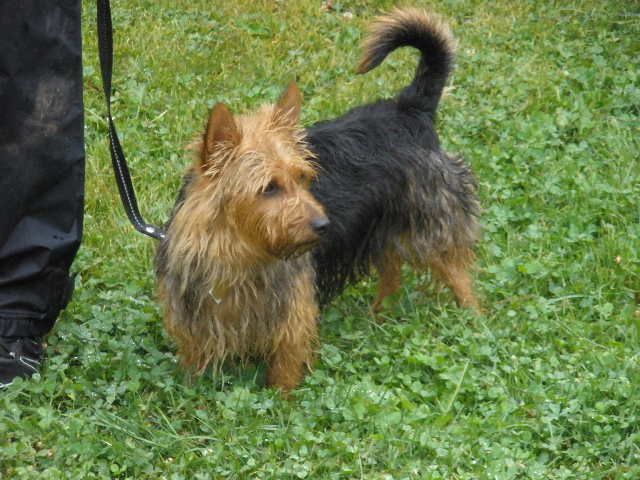
In the afternoon we returned to the badger and this time Ronja barked a time or two, but still seemed very uninterested. It was a completely different deal when the Border Terriers or the Welsh Terriers saw the badger. Those guys really knew how to make themselves noticeable. They barked and barked!
The next day Kit decided that Ronja should try to see the badger for real, but in a different cage that allowed her to see all of the badger. But, again, Ronja had difficulty understanding why she should find this strange creature in the cage interesting. The badger just sat there and did nothing. Ronja did not find it funny or exciting. Kit scratched his head, looked at me and said, “Tell me again, what kind of work do you use an Australian Terrier for?” It was at that moment that I knew hunting underground with Ronja was not possible.
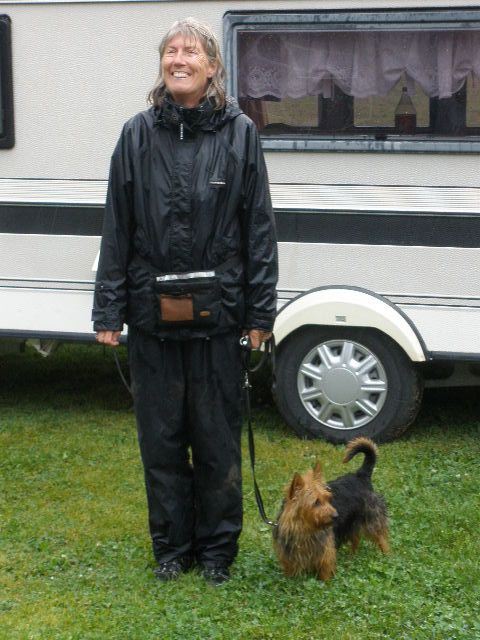
Ronja and Marianne Elmgren
But, our little mishap did not stop me. I decided to try Ronja with wild boars. I contacted the trainer and together we went into the fenced area where the boars lived. We walked and walked through the high grass and suddenly there they were, three wild boars starring at us! Ronja stopped and you could see her thinking, “three against one? This seems fair to me!” She then ran into the pack of boars as fast as she could and then ran back to us with a look on her face which clearly read, “Did you guys see me?” Well, the boars certainly did and one of them attacked her, but Ronja only saw this as a challenge. She ran away and then turned back to the pack again, barking the whole way! She was anything but scared and it was clear to see that she was having a blast! After Ronja was done, one of the Welsh Terriers tried, but he was afraid of the boars. The boars ended up chasing him into a nearby pond!
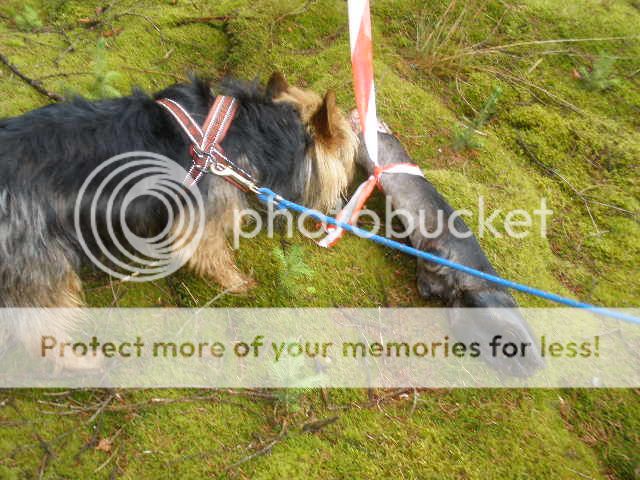
On the following Saturday we had the opportunity to test the dogs on the wild boars. The judges looked at the dogs’ reaction to the boars, if they were afraid or if they challenged the boars, if they were tense or relaxed, and, finally, if they needed support from the owner. In the end we received the final scores and Ronja did very well considering the fact that she was so inexperienced. She was categorized as “good possibility of positive development” and I was very proud!
I was also very interested in tracking and I decided to let Ronja try it. We never tried tracking before (I find it boring) but I have to say that I have now changed my perception! Our first trail was 400 meters long. The scent trail was three hours old and one could get the idea that Ronja had done this a hundred times before. She just put her nose to the ground and did the job. Our next trail was 600 meters long, also three hours old, and it changed direction four times. This one also went very well. After this I decided to try to test Ronja. At the test the trail would be 600 meters long with a three hour scent trail that changed directions four times. There would also be 20 meters where no blood trail was used. There were six dogs at the test: two Border Terriers, three Welsh Terriers and Ronja.
I was extremely excited and also a bit nervous! It is one thing to go on a trail where there are markings and help from an instructor, but quite another to be on our own under the watchful eyes of a judge with only Ronja’s nose to depend on!
Then it was our turn. I walked Ronja to the starting line and away it went. Ronja started out strong, but then she suddenly stopped and returned to the judge. She looked at him like she was thinking, “This strange man that my mom just picked up in the parking lot not less than five minutes ago is now also a member of our pack and he must not be left behind!” After she returned to check on the judge for three times, he said (and this is the only thing he said the entire time), “I’ll have to walk up here with you because your dog has a highly developed instinct for herding and it frustrates her that the pack is not together.”
So the judge and I walked closely together and Ronja was satisfied. The first two times the trail changed direction, Ronja did fine, but, the third time, she was not so sure. She lost the scent and looked at me for help, but since I have no fine nose for picking up a trail, I had to look back and say, “I’m sorry, sweetie, but you’re on your own here.” She kept running around to try to pick up the scent again and suddenly she got it and then she ran really fast! She ran uphill and downhill, through rough terrain, and I had to try to get her to hold back a little, which was no easy task! Then, all of a sudden, we were at the finish line! The judge smiled and said, “Very good trail work; the test is passed.” I was so happy and surprised that I gave him a huge hug! Ronja was also hugged and kissed for being such a good trail dog!
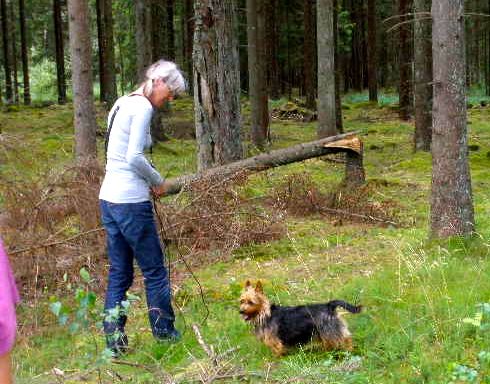
Three of the six dogs enrolled in the test passed, all bitches, one Border Terrier, one Welsh Terrier and then my Ronja!
On Sunday afternoon we drove home to Denmark after having a couple of great days in Sweden and it is not the last time I enrolled in such a training camp! I ended up working with something different than I thought I would, but I also ended up learning so much more about my dog. And Ronja? She is such a capable dog and I’m so proud to be her owner! Marianne Elmgren
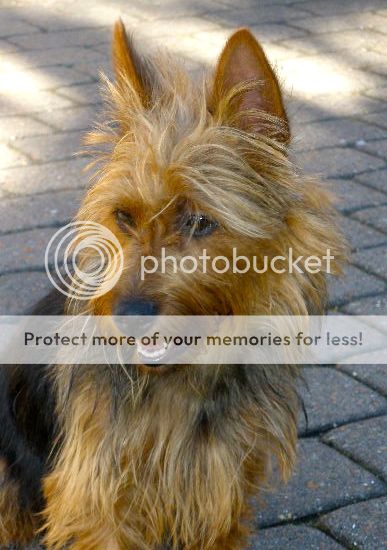
Ronja
|
| Juniors Victoria Chatham |
|
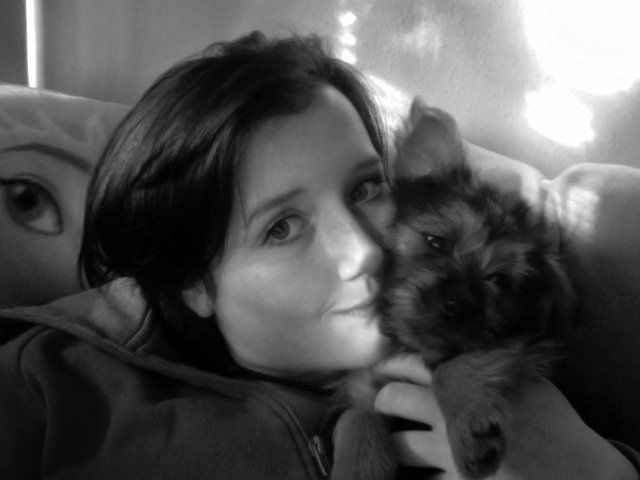
Victoria and Chatham’s Just Bunny-Bear
Currently I am the only Junior Handler showing Aussies. I wish there were more.
Last year I was the number 1 Junior Handler in the Terrier Club, so I think I did pretty good.
I have never shown one of our dogs in the Bred-By class but I do show some of our dogs in the race (breed). Mostly I show the bitches and my mom shows the males.
I think the World Dog Show was a great experience. It was fun to meet all the different people and see dogs that I’d never seen before. In Denmark we normally have only 10-15 Aussies at a dog show. At the World Dog Show there were 60 Aussies and I had never seen so many Aussies at one time!
The first picture is of “my princess,” Bunny and me taken about six months ago. Bunny (Chatham’s Just Bunny Bear) is one of the dogs we bred. When Bunny was just a few days old I began calling her “my dog.” There were six puppies and overtime she was the only one I called mine. She turned out pretty good and my mom let me keep her. She’s still my little princess. Next year I will be in exchange student in France.


My mom, Minna, showing Chatham’s Anna Isabel (Anna) and me showing Chatham’s Just Bunny-Bear (Bunny)

Minna Chatham would like to add that they got “Queenie” from Orvokki Lämsä. “I went to Finland and picked her up. I stayed 4 days at Orvokki´s home. She is a lovely person and she knows so much about the dogs. It was a great experience for me. We even went to a dog show.” Minna said, “I really enjoyed the ATI article about Orvokki, last month. I am so happy for her that she received ATI’s Lifetime Membership.”
|
| Danish Green Hotel Where You Can Cycle For Your Meal |
| At the Crown Plaza Copenhagen Towers, in Denmark, you can actually cycle for your meal.

Starting April 19, 2010 they will give a free locally produced meal to any paying guest who can generate an additional 10 watt hours of electricity. The hotel figures that a guest cycling at 30 kilometres per hour (average speed) for 60 minutes will produce approximately 100 watt hours of electricity. At that speed you can get a free meal in about 6 minutes. Power generated by guests through this initiative is stored in a battery and fed back into the main power supply of the hotel. iPhones mounted on the bike handle bars will tell riding guests how much juice they’re pumping. Beginning June 2010 guests will also be able to compete against the hotel’s solar panel system to see who can produce the most electricity in the same period. The hotel has a goal of becoming carbon neutral. They will test the program for one year and then you may see it in other Crowne Hotels.
They are also pet friendly for small dogs, like our Aussies. There is an additional charge for dogs, however.
To learn more about this great hotel Click here
|
| News From the USA2010 ATI Budget In Review By Pamela Levy |
|
ATI began January 1, 2010. In 2010, we raised $5907.00 in dues and an additional
$1955.02 in stock market gains and $178.16 in interest. Additionally I contributed $5000.00 to cover ATI’s 2 grants for research. Our ATI fund currently has more than $31,671.20.
The grants ATI sponsored this year are helping to fund the research for two different studies targeted at hemangiosarcomas.
Grant 1139: Immune Targeting of Canine Hemangiosarcoma Using a Canine Derived Single Chain Antibody Approach
Grant 1429: Mechanistic Relationship of IL-8 in Cell Proliferation and Survival of Canine Hemangiosarcoma
For ATI Members to read more about the grants and the research studies
click here
When the studies are complete we will share the data with all countries.
If your country would like us to concentrate $5000 this year on specific research please let us know. We will learn what studies are being done and let you know.

Costs For Fiscal Year 2010
All Website Costs-underwritten by Theresa Goiffon
All Constant Contact Newsletter Costs-underwritten by Pamela Levy
All Education Night Call-In Costs-underwritten by Sue Holsinger
All Photo Shoots for Chef’s Corner and Crafts-underwritten by Cheryl Mechalke
Trademark Expenses and All Other Expenses-underwritten by Pamela Levy
As you can see, all YOUR money goes directly towards making a difference
for the health of our Aussies.
Thank you for your trust in us. We are proud to say, we have earned it.
Thank you so much for your support. Without you, there would not be an ATI.
Integrity, Transparency, Staying True To Our Mission and Goals, Serving You and Your Beloved Aussies, Continues to Guide our Way!
|
| Giving Pet’s Medication-A Few Tips |
| If your dog refuses to take pills or spits them out, here are a few tips.
If your vet says that the medication can be given with food you can try the Greenies pill pockets.
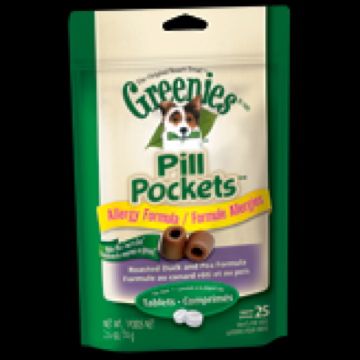
Greenies makes pill pockets for capsules and pills in two different flavors. My dogs love both the chicken and the beef. They also have a new formula for dogs with allergies.
For more information and to go to the Greenies website Click Here
You can also hide pills in a variety of food products. The most common foods to use are cheese, marshmallows, meat pieces, cream cheese and peanut butter or apple butter as a low fat alternative.
If you do not have any food to disguise the pill, try the technique below.
For a video on how to do it, click here.
Gently grasp your dog’s head using your non-dominant hand. If you are right-handed, use your left hand. Place your hand on top of the muzzle with your thumb on one side and your fingers on the other.
Avoid holding the lower jaw, and do not hold it so tight that it is uncomfortable or the dog cannot swallow. You may need someone to help hold the front legs and chest of the dog to hold him/her still. Wrapping the dog in a towel or blanket is a good restraint technique.
Once his head is held in place, raise his nose to point toward the ceiling and firmly squeeze in just behind the upper canine teeth. The mouth should then open.
Use your other hand to administer the pill. Place the pill between your thumb and forefinger. Use your little finger, ring finger or middle finger to lower the jaw by applying pressure to the teeth between the lower canine teeth.
After the mouth is fully open, place the pill as far back in the mouth as possible. Avoid placing your hand too far into your dog’s mouth. You may stimulate the “gag reflex” and this will make the experience unpleasant and make future medication administration attempts more difficult.
Close your dog’s mouth and hold it closed. Gently and briefly rub your dog’s nose or blow lightly on the nose. This should stimulate him to swallow.
The quicker you perform this procedure, the more cooperative your dog will be.
Always remember to praise your dog and offer a treat after receiving medication. This will help make future medicine times easier.
The above tips are from Dr Jon at PetsPlace.com . For a free newsletter click here. |
| Seizures |
| I received a phone call recently from an Aussie owner in tears. She had just witnessed her 6 year old Aussie have, what she believed, his first seizure.

Did I know what to do or the possible cause?
I immediately called Sabine Baker, of Aussome Kennels in the US. Sabine has so much more knowledge than I do and is always there for us ready to help. A big thank you to Sabine!
She asked several questions.
Was the dog on Heartguard which may lower the seizure threshold?
What food was he on?
Was this his first known seizure?
The dog was on Sentinel and Comfortis.
Sabine told us that Sentinel is “effective against” whip worms but will not keep a dog FREE from them. That is a HUGE difference! It has the same effective ingredient as Interceptor, which is what we use for our dogs. One of our dogs (who is on Interceptor year-round) just tested positive for whips. Testing positive for whip worms on the first test is a miracle. You can spend a fortune in vet bills before you get a positive test for whip worms. We will now treat all the dogs, that came in contact with her, with Panacur this week.
None of the heartworm medications are guaranteed to keep your dog completely free from intestinal parasites. Parasite breakthroughs are very common. Since it often takes multiple fecal exams to detect whip worms (they have to be in the right stage of their life cycle to be spotted), in my opinion, it generally makes more sense to simply treat with Panacur once or twice a year to prevent problems.
Both Sentinel and Comfortis list seizures as possible side effects.
The dog has since gone in for a complete medical work up. His bloodwork came back showing him to be low or hypo thyroid, which can also cause seizures.
Here’s a great website with everything you ever wanted to know about canine epilepsy: Click Here
For more information on what can cause seizures in dogs: Click here
Please consult your vet immediately if your dog has seizures. Make sure you keep a list handy of medications he/she is on. I would even add over the counter things you may be giving your dog. Wishing you happy and healthy Aussies.
|
| What People Are Saying About Our ATI Aussie Video |
|
To View
Click Here

Photo Courtesy Of Pamela Levy
WOW! I am IMPRESSED!!! This is an excellent and FUN video. Thank you for providing it and making it!!!! Applause! Applause!
June Hulit (owner of an Aussie Rescue)
This was GREAT! I really enjoyed the pictures, especially the one reading and the one on the computer…so cute!! Terri Butchkavitz
We love the great video! Agneta Simonsson
Fantastic! What a great job; I love it! All the best, Dianne Wall |
| CERF Testing |
| If you are thinking about using an American Aussie in your breeding program and want to know if the dog has had its eyes tested, we are providing you with a link to the Veterinary Medical Data Base, CERF Registry Lookup, to see the results for yourself.
You will need the name of the dog or the registration number or the kennel name in his registered name.
The information provided will be the dates of the testing(s) and the results such as Normal.
You may have questions as to why so few US Breeders are listed here.
*A person in the US can test the eyes and decide not to send the results for $12 to CERF.
*They may send in the results and ask for the results to remain confidential for whatever reason.
*They may not test. If people are not breeding their dogs they may opt to NOT test at all.
*Testing in the US is not required for breeding
The test results are good for only one year.
Why is testing important?
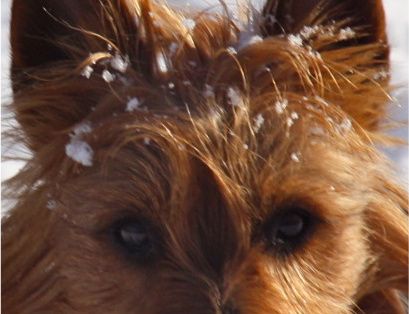
IF YOU ARE A BREEDER, you do not want to produce eye diseases.
In the book, Control of Canine Genetic Diseases, written by George A. Padgett, DVM, Dr. Padgett describes the genetic disposition of different diseases, by breed. There are 53 ocular problems or diseases that different breeds of dogs can be genetically disposed to.
Dr. Padgett claims Aussies have a genetic disposition to three ocular (eye) diseases. (That does not mean they cannot develop other eye problems, such as a dry eye or blindness as a result of diabetes!)
These are the three eye problems that Aussies are genetically disposed toaccording to Dr. Padgett:
1. Cataracts, which are a lens opacity that obscures vision and may cause blindness. The mode of inheritance is undetermined and the age of onset varies.
2. Progressive Retinal Atrophy (PRA), which is a degeneration of the retinal vision cells, which progresses to blindness. The mode of inheritance is recessive, undetermined and age of onset varies.
3. Retinal Dysplasia (Folds) which are abnormal folds in the retina due to faulty development. The mode of inheritance is recessive, undetermined and age of onset is under one year of age.
IF YOU ARE A PUPPY BUYER, you want to ask if the parents of your potential puppy has been tested and go to this site to see the results.
If the results are not there, you may want to ask why. When you CERF test your dog, you are provided with paperwork for your files. Your breeder may not have filed them with CERF but can provide you with the paperwork from the testing.
If you have an Aussie that has developed an eye disease, please make sure you report it.
This is confidential but you can be an important part in trying to eradicate these diseases.
_________________________________________________________________
GREAT NEWS: APRIL 1-AUGUST 31, 2011, CERF tests sent in will receive the kennel rate of $8.00 instead of $12.00. This is a wonderful savings. You must download the voucher here and send it in with your CERF paperwork. This is for everyone. If you have completed the CERF test but not filed it with CERF now is the time. If you have not tested your dogs eyes, please consider doing so.
__________________________________________________________________
Click here
CERF REGISTRY LOOK UP
For your own copy of the book, Control of Canine Genetic Diseases, (Howell reference books) by George A. Padgett (Oct 26, 1998) click here. Amazon has the hard copy on sale for $20.40 and the Kindle edition, great for international members, is $15.37.
|
| Earth Day April 22, 2011 |
| Help celebrate Earth Day globally, with your Aussie, by going green.
Feed your dog and yourself organic foods. Try to avoid fruits and vegetables with pesticides sprayed on them and meat with added hormones and antibiotics. In the US look for labels stating, “USDA Organic”.
For Organic Food and Treats Click Here Sojos Petguard
Use chemical free household cleaners. They are better for your dog, better for you and better for the environment. Don’t forget to recycle those empty bottles.
Try my favorite Parsley Cleaner. I use it everywhere for everything. I even clean my crates with it.
Use chemical free shampoos for you and your favorite Aussie. Look for shampoos there are paraben and sulfate free and don’t forget to recycle the empties. Check out Natural Dog Aromatherapy for great shampoos.
Use less toxic items for fleas and ticks!
You may want to try the tic-clip from Germany

For More Information Click Here
This product sounds too good to be true: a clip on tag that repels fleas and ticks without any chemicals, or even herbal sprays, for two whole years! Developed in Germany, it uses a biomagnetic field to create a natural energy barrier around your pet, so that ticks and fleas do not jump on board. It takes up to 20 days to reach full effectiveness and can be affected when your pet is sick or has been vaccinated, but overall most pet owners that have tried it rave about it and are delighted at the reduction and often complete elimination of ticks and fleas. Even though the initial investment is more than conventional flea treatments, if it works well for your pet it will save a fortune over its lifetime, as well as keeping your home free of toxic chemicals, so it is definitely worth a try.
Use eco-friendly poopie pick up bags that are biodegradable.
For great pet waste products and composters click here
Buy eco-friendly leashes and collars, toys and beds. You can find items made from hemp as well as items made from recycled items.
Hemp Leashes and Collars and All things Hemp Click Here
Eco-Friendly Beds Click Here and for more Eco-friendly beds Click Here
Eco-Friendly Toys and Eye and Ear treatments Click Here
Reduce your carbon footprint; walk to where you are going with your dog instead of driving.
Recycle your puppy toys and beds. Drop them off at your favorite animal shelter or rescue organization.
Green Boarding and Pet Camp
If you are lucky enough to live in San Francisco, USA, or be visiting with your dog, visit the All Green Pet Camp. They have day care as well as over night boarding. For more information: Click Here
The ultimate source for All Things Healthy check out the BIg Bad Woof
For a wonderful list of healthy items for your dog, click here You will want to print that list!
Other wonderful places to visit:
The Only Natural Pet Store
For more Green information Click Here
If you are changing your dogs diet, level of activity or any products you use, we advise discussing it with your veterinarian.
|
| Just For Fun…… |
| Did you know that over 50% of all pet owners would rather be stranded on a desert island with their pet, not another person.
An estimated 1,000,000 dogs in the U.S. have been named as the primary beneficiaries in their owner’s will.
An American Animal Hospital Association poll found that 33% of dog owners admit to talking to their dogs on the phone and leaving answering machine messages for them while away.
70% of people sign their pet’s name on greeting and holiday cards and 58% put pets in family and holiday portraits.
Toto’s role in the Wizard of Oz was played by a female Cairn Terrier named Terry. Terry was paid a $125.00 salary each week. (The people who played the munchkins only received $50.00 a week.)
Studies have shown that people who own pets live longer, have less stress and have fewer heart attacks.
|
| US Stats Through February 28, 2011 |
| BREED AS OF 2/28/11
1 GCH BLACK BACK FIREFLY D 62 (P. Levy)
2 GCH KAMBARA’S ZEBULON D 58 (A. & C. Mitchell)
3 CH RYBA’S NOTHING BUT BLUE SKIES D 33 (P. Levy)
4 GCH NELLYSON’S MR DON’T SKIP THE ZIP D 30 (C. & J. Mechalke)
5 CH DUNHAM LAKE SCOUT MASTER D 27 (T & J Steinmetz & T Goiffon)
6 GCH ABQ SAN ISIDRO CHRISTHILL D 22 (K. Hill & W. Christensen)
7 CH BLUEPEPPERS MAY DAY B 16 (B. Saunders, E. Steele, M. Ahola)
8 CH BENAYR BIBBIDI BOBBIDI BOO B 13 (T. Nelson)
9 GCH BENAYR CLAY TUCKER D 13 (L. Weaver)
10 GCH MERRIGANGS WILD N’ CRAZY GUY D 9 (H. Rife)
ALL BREED AS OF 2/28/11
1 GCH KAMBARA’S ZEBULON D 3101 (A. & C. Mitchell)
2 GCH ABQ SAN ISIDRO CHRISTHILL D 489 (K. Hill & W. Christensen)
3 GCH NELLYSON’S MR DON’T SKIP THE ZIP D 206 (C. & J. Mechalke)
4 CH BENAYR BIBBIDI BOBBIDI BOO B 133 (T. Nelson)
5 GCH BLACK BACK FIREFLY D 62 (P. Levy)
6 GCH MERRIGANGS WILD N’ CRAZY GUY D 48 (H. Rife)
7 CH RYBA’S NOTHING BUT BLUE SKIES D 33 (P. Levy)
8 CH DUNHAM LAKE SCOUT MASTER D 27 (T & J Steinmetz & T Goiffon)
9 CH BLUEPEPPERS MAY DAY B 16 (B. Saunders, E. Steele, M. Ahola)
10 GCH BENAYR CLAY TUCKER D 13 (L. Weaver)
EUKANUBA AS OF 2/28/11
1 GCH KAMBARA’S ZEBULON D 281 (A & C Mitchell)
2 GCH BLACK BACK FIREFLY D 82 (P. Levy)
3 GCH ABQ SAN ISIDRO CHRISTHILL D 35 (K. Hill & W. Christensen)
4 CH RYBA’S NOTHING BUT BLUE SKIES D 33 (P. Levy)
5 GCH BENAYR CLAY TUCKER D 33 (L. Weaver)
6 GCH NELLYSON MR DON’T SKIP THE ZIP D 33 (C & J Mechalke)
7 GCH RYBA’S LICENSED TO SHOP AT REDSKY B 32 (E. Strid)
8 CH DUNHAM LAKE SCOUT MASTER D 27 (T & J Steinmetz & T Goiffon)
9 CH JASKARIN COMMENDATORE FERRARI D 20 (K. Occhuiti)
10 GCH BLUE MOON CALL ME IRRESISTIBLE D 19 (J. Popvits)
http://www.caninechronicle.com/Statistics/
http://www.dmcg.com/CurrentBreed.asp
http://www.dmcg.com/CurrentGroup.asp
http://www.dmcg.com/CurrentGroup_2.asp |
| Bark Out! |
| Well, I must say, you’ve done it again. I read the ATI through teary eyes. The photos are so beautiful, and the stories about Rescue are to cry over, but all with happy endings, I hope. I don’t know how people can give up one of these wonderful dogs. Congratulations, on another wonderful issue of ATI. It sure helps me feel connected in a way not otherwise possible at this time in my life, with Australian Terrier owners. Gratefully, Judy Stallings
What a great job you do with the newsletter. Those pictures of all those wonderful dogs are simply outstanding. A Great Big Thanks!. Hal Wilcox
You out did yourself with the Jan/Feb issue of ATI…. I want one of those dogs!!!!! Heather Rife DVM
Lovely newsletter, thank you again! Sue Holsinger
The newsletter is always interesting, a really great initiative. I admire you for all your work and dedication! Jill Grenaae |
| Cruft’s Winners |
| Congratulations to Marjo Ahola and Eija Hyvonen owners of BOB winner Jaskarin Peperuncino “Kino”. Kino is currently in the UK at Silhill and Sherex Kennels. He was shown by Felicity Freer.
Best of Opposite Sex went to Ch. Silhill Sweet Pea owned by Ms. Sue McCourt and Ms.Bartolomio.
The Judge was Mr. M. Murray.
For the complete list of entries and results click here.
We will do a complete story in the April/May newsletter featuring the dogs of the UK.
|
| Join ATI |
|
WE HOPE YOU’VE ENJOYED THE NEWSLETTERS
AND WILL JOIN US.
WITH YOUR PAID MEMBERSHIP YOU WILL GET ACCESS TO THE WEBSITE, BE ABLE TO DOWNLOAD FREE ARTICLES, GET THE LATEST NEWS ON VACCINE PROTOCOLS, BE ABLE TO SHOP IN THE AUSTRALIAN TERRIER MARKET AND SO MUCH MORE.
To Join Click here
Join us on Facebook (free)
|
|
|
|
|
|
|
![]()
![]()
![]()
![]()